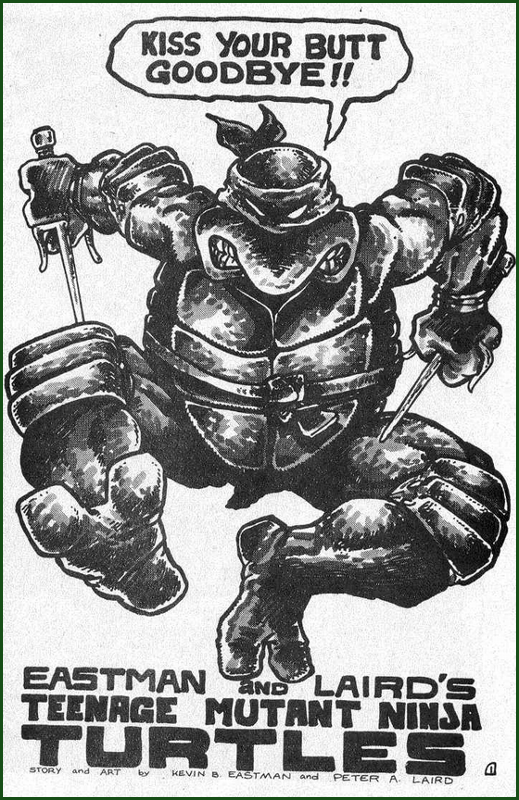Teenage Mutant Ninja Turtles & Other Strangeness by Alien Rope Burn
"This book is dedicated to the two greatest game master in the world, Kevin Siembieda and Rene Vega."
Original SA post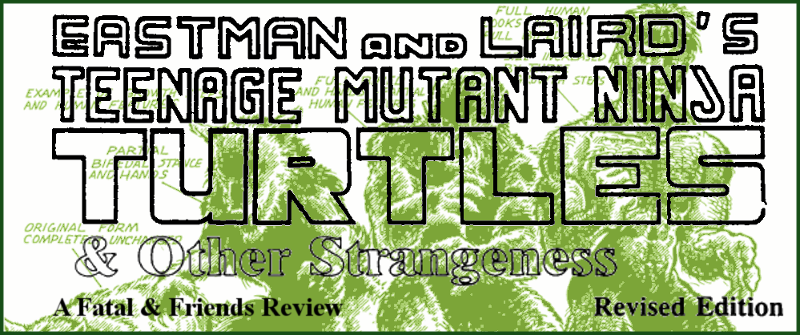
Teenage Mutant Ninja Turtles & Other Strangeness Revised Edition, Part One: "This book is dedicated to the two greatest game master in the world, Kevin Siembieda and Rene Vega."
So, time for me to do a review of my "first" role-playing game. Not the first I was exposed to - that was Dungeons & Dragons. After seeing the Basic set, I was all set to get the Advanced Dungeons & Dragons Player's Handbook, Dungeon Masters Guide, Monster Manual, and Monster Manual II for my birthday. And then a certain episode of 60 Minutes aired. All of a sudden, AD&D was a no-go. Granted, I could still look at my friends' books, and borrow them. I also got to see other RPGs like Traveller or Marvel Super Heroes floating around. But then, when at a convenience store, my parent offered to let me get a comic book. They didn't have my usual Marvel comics, so I picked up this:
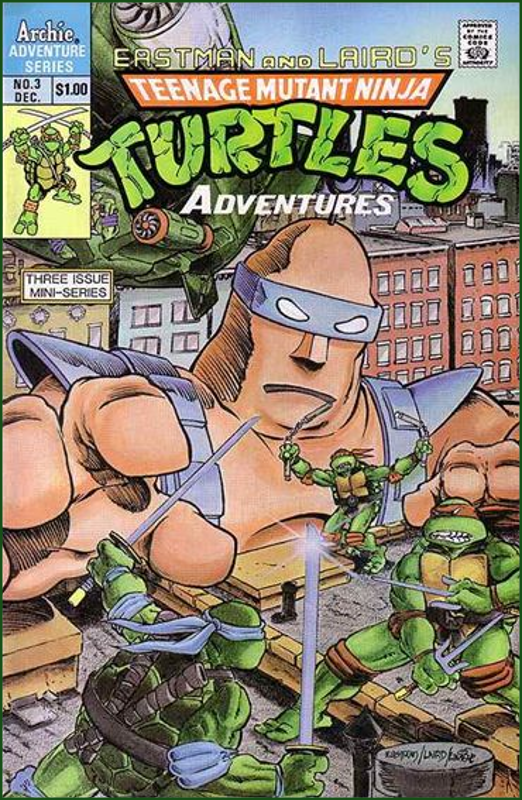
It was weird and interesting, so I picked up the first issue as well. It was goofy and had cool ninja stuff, which I already liked, but it's hard to explain why I glommed onto it. It just had enough weird ideas to be like nothing I'd seen before, and I wanted more. Never found the second issue, though. Instead, when stopping by my comic store, I ran across this-

It's hard to describe how exciting this was at the time. It had an RPG?! And because it had a comic insert and didn't have "RPG" on the cover, I was able to slip it under my parent's nose as being a comic collection. And that's how Teenage Mutant Ninja Turtles & Other Strangeness became my first RPG. And through it, I was able to find out about the original Teenage Mutant Ninja Turtles comics. I was able to find this one:
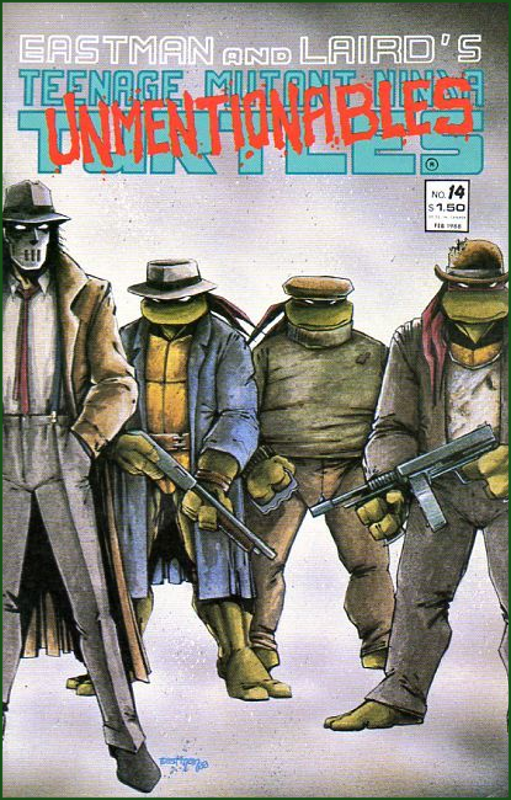
Not the best issue to start on, but it was grounded and genuine in a way few comics I had read at the time were, strange as it may be to say. Even at a young age, I had come into the belief that Batman and Superman were for very small kids, based on the cartoons they were in at the time and the comic digests I'd gotten from time to time. And though I'd gotten into some Marvel books due to them having characters that felt more like... characters, with motivations and relationships that roughly resembled those of real people, the turtles were fuckin' street. They stabbed bad ninjas and weren't afraid of nothing, with a casual affectation to them that kept the whole thing relatable. By the time the turtles cartoon came out, I was already a little black and white comics hipster. I mean, the cartoons were alright, but I was always able to recognize it as the kiddified version. And no kid wants the kiddified version when they know the adult thing is out there. I mean, that's why I'd wanted AD&D and not D&D.
And before I get too far into this thing, I want to acknowledge the author, Erick Wujcik, for making a game that drew so many kids into the hobby like myself. At no point was the game sanitized to match the cartoons starting at the time, and it was both edgy for my age and compelling. With fifty-eight different animal types to play and a point-buy system, it excited my little nerd brain, and there were lists of guns and weapons, and all sorts of numbers to jot down. I was hooked. I want to thank him for the Amber DRPG, the first indie RPG I was exposed to, the one that dragged me into an older playing group I've been with to do this day. His contributions to the hobby are fairly major, and I don't want to discount that. But I'm going to take my usual critical eye to things, and this is a Palladium game, It's aged better than Rifts has rules was, but that's a very relative statement to make.
Some of you may realize this isn't the first time this game has been on FATAL & Friends, but Forkbanger's review focused almost solely on the mutant animal creation rules, and there's a lot to cover besides just those. Though they're the star of the show, there's a lot more to bring up I feel was skimmed the first time around. Also, just as a note, sometimes I'll be using Turtles comics material that isn't in the book itself, and when I do, it'll have a green border like this:
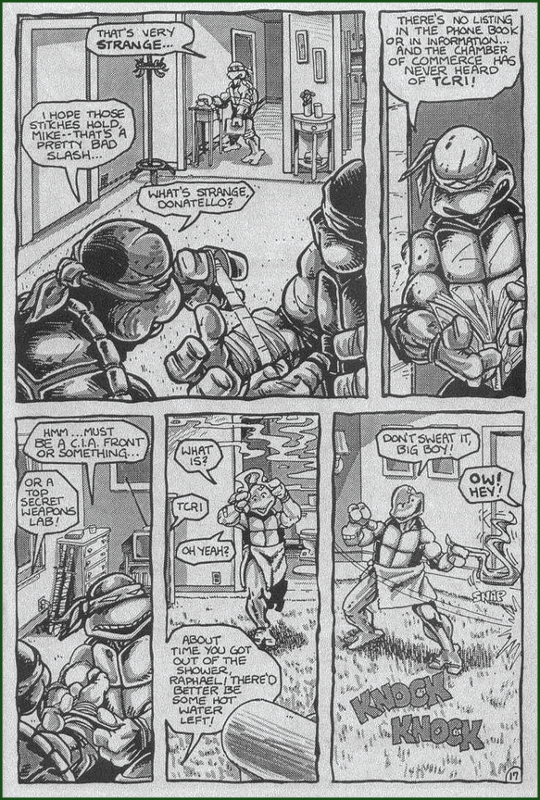
Why, yes, it was the eighties. Also, why is he wearing a towel? Hm.
Next: Some slightly more relevant digressions.
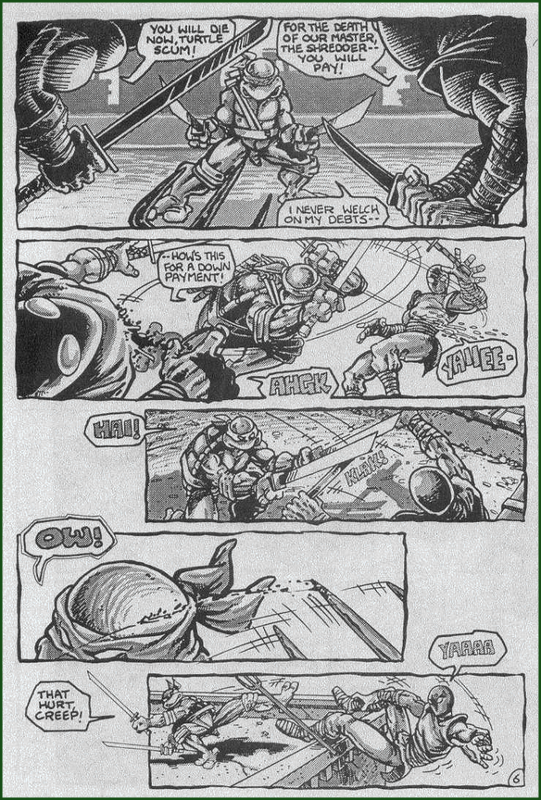
"When running my own campaigns, I frequently deprive characters of all their various powers and possessions."
Original SA post
Teenage Mutant Ninja Turtles & Other Strangeness Revised Edition, Part Two: "When running my own campaigns, I frequently deprive characters of all their various powers and possessions."
Just About Any Palladium Book posted:
Warning!
Violence and the Supernatural
... does not lead off this book, as this book predates Rifts and those sorts of cautionary warnings. However this book may have led to that, as it represented Palladium's first and probably only clash with parental figures, but we'll be getting to that in just a bit. Instead, Wujick starts out by bringing up the fact that anthropomorphic animals have had a long history in fiction, citing comics like Cerebus and Howard the Duck to cartoons like Warner Brothers and Superdog. As such, he kind of offers it as a kit for anthropomorphic animals in general, though I imagine somebody trying to run a Looney Tunes game might be disappointed when a mole PC whips out an uzi and guns down the dog chasing him. To his credit, though, he names and thanks all of his playtesters on this book.
Now, here's the weird part: this book is only based around the first four issues of the black and white comic book, plus the Raphael one-shot. Not much was established yet, but no other mutant animals existed in the comic other that the titular turtles and Splinter (the mutant rat). In fact, the black and white version of the comic book has almost no other mutant animals than the turtles themselves. You have Leatherhead, a pacifistic sewer alligator mutated by the same alien ooze that mutated the turtles. Later on, we'll have Bloodsucker, an ordinary leech that gets mutated for a short time by drinking Raphael's blood... and that's about it. There are other mutants and oddities, to be sure, but additional mutant animals? Those are almost entirely a product of the cartoon and Playmates toyline, with their need to have waves upon waves of marketable characters. As such, the RPG diverges almost entirely from the comic, having a whole underground of mutant animals floating around - not many, but enough that there are different groups of mutants introduced with each adventure, each with their own ridiculous origins. This isn't a complaint per se, but more a curious observation of how the game diverges from the actual comic.
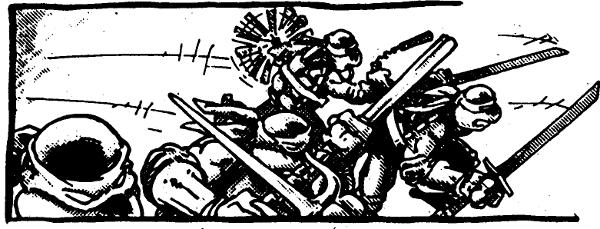
We're told this is a complete game several times, but with a concession that they couldn't include every animal you might want. After the playtester credits, we immediately get into a diatribe regarding random character generation. See, this book is unusual for Palladium character generation at the time in that it introduces a new point-buy trait: Biological Energy, hereby abbreviated as "BIO-E" universally hereafter. Each animal gets a certain amount of BIO-E points to either retain natural traits, mutate closer to humanity, or alter their size. However, the book retains things like random rolls for attributes, animal type, origin, etc. Wujick gives three reasons for retaining these:
- "Excellent players can role-play ANYTHING."
- "... the convenience it provides to the game master.", as in being able to just random-roll characters up when necessary using the PC rules.
- "Finally, let's not forget that random rolls reflect real life."
We then get "how to play a role-playing game" where we are asked to envision ourselves as Raphael confronting a bat-mutant burglar with a gun, and asks "What are YOU going to do?"
Flip out and stab a bat, duh.
Next: A Palladium primer.
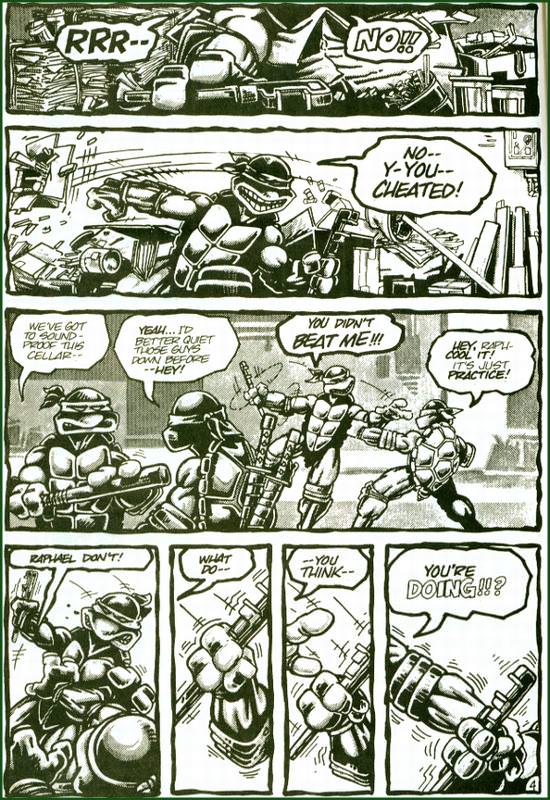
"In other words, when the hero tangles with the villain you've got to be able to figure out the winner."
Original SA post
Teenage Mutant Ninja Turtles & Other Strangeness Revised Edition, Part Three: "In other words, when the hero tangles with the villain you've got to be able to figure out the winner."
So, rather than cover the rules in-depth, I'll just give a quick primer to Palladium rules so we can skip over most of the duller sections of the book:
- Characters have eight attributes: Intelligence Quotient (IQ), Mental Endurance (ME), Mental Affinity (MA), Physical Strength (PS), Physical Prowess (PP, don't laugh), PE (Physical Endurance (PE), Physical Beauty (PB), and Speed (Spd). Of these, the main important ones are Physical Prowess (bonuses to nearly every combat roll), Physical Strength (bonus to melee damage), and Intelligence Quotient (bonuses to every skill). The Endurance traits give bonuses on saves.
- Characters have Hit Points (HP, increased by level and Physical Endurance) and Structural Damage Capacity (SDC, increased by skills and mutations). SDC is supposed to be the "flesh wound and bruises" level of damage, predating many of the d20 systems that would use a similar mechanic by nearly 20 years. Armor has an "Armor Rating" which you have to roll over to hit the wearer directly; otherwise, the damage is applied to an SDC rating of the armor. Once the SDC rating of the armor is depleted, it's no longer useful. Some characters will have natural armor, and this can stack. MDC does not exist in this version of the Palladium rules.
- When injuries deplete SDC down to 20% remaining, you take a random impairment from a table which provides minor penalties that lasts about half a week. When you're down to 15% of your HP, you're considered to be bleeding and lose 1 HP a minute unless medically treated. There's are optional rules for more severe crippling injuries when down to 25% of your HP, and another optional table for permanent attribute loss when reduced below 0 HP. Going below 0 HP puts you in a comatose state, and going below your Physical Edurance in negative HP kills you outright. Every hour you're comatose, you make a "save vs coma/death", a percentage roll with the base percentage being based on the quality of the person treating you, the facilities they have available, and with a bonus if you have a high Physical Endurance. If you make two out of those three saving throws, you survive. If fail at this for a number of hours equal to your Physical Endurance, you die.
- Characters have a certain number of attacks each melee round (15 seconds), mainly determined by their martial arts skill. Yes, this means things like martial arts and boxing make you faster at shooting guns. It's a Palladium thing. Some defenses, like dodges, expend your attacks for a round. Others, like parries, do not. You can't parry bullets or lasers, so that's why that comes around. If you're out of attacks in a melee round, you can't make an attacks or dodges, and half to wait until next round. Initiative is determined by a roll but the exact combat order is vague. Characters that attack unaware targets automatically win initiative.
- Attacks are on a d20 plus bonuses from either Physical Prowess, Weapon Proficiencies, Hand to Hand skills, some rare skills, or some combination of the above. Your defense roll (Parry, Dodge) has bonuses from Physical Prowess, Hand to Hand skills, and some rare skills, and has to exceed the attack to avoid it. If you're hit by a blunt attack, you can make a secondary attempt to "Roll" with the hit (improved by some skills) to halve the damage. A natural 20 is a critical hit that can only be defended with by another natural 20, and inflicts double damage.
- Damage is per weapon, ranging by 1d4 and 3d6 for melee weapons, and 1d6 to 7d6 for guns. Melee weapons add a damage bonus based on Physical Strength if it's very high. Automatic guns can unleash multiple bullets in one spray, and you can easily multiply your damage by 5 or more depending on your number of attacks, or riddle multiple targets. As such, heavy automatic weapons are generally the dominant weapon if you can obtain them, with only two-handed swords wielded by top-strength monster mutants coming close.
- There are some obscure rules; simultaneous attacks let you hit somebody as they're hitting you and neither gets defense. There are jump kicks and leap attacks that let you use up all your attacks for a round to do double damage. You can attempt to entangle to trap a weapon or arm with a strike instead of doing damage. Paired weapons let you do two strikes for the price of one attack, but then you have expend attacks to perform parries for the rest of the melee round after doing that. Poisons require different saving throws with a d20 against a difficulty of 14-16 to resist their effects, with a bonus for high Physical Endurance. Psionics also can be resisted with a saving throw (difficulty 10 if you're psionic, 15 if you're not) with a bonus from high Mental Endurance.
- Skill rolls are done by trying to make a percentage roll under that of your skill's rating. Sometimes your skill rating is penalized. This is intuited from examples; the book never actually states how to make a skill roll.
- Characters gain XP at the end of an adventure based on its challenge, their accomplishments, and nebulous "RP awards". Characters can easily gain XP at different rates as a result. XP grants you levels, and each level levels up your skills and grants an extra 1d6 HP.
- Though insanity is referenced by some mechanics, the insanity rules are not actually present in this Palladium game. This is because the original printing of Teenage Mutant Ninja Turtles and Other Strangeness included the insanity rules with a "sexual deviation" table, which included homosexuality and pedophilia (scanned here, for the morbidly curious). As such, a blow to the noggin or trauma could literally turn you gay or on to kid-piddling, and it's easily the biggest blunder Palladium ever made in text. From all appearances, they were likely copy-pasting summaries of the Diagnostic and Statistical Manual of Mental Disorders circa around 1980 (before homosexuality was removed as a "disorder" later in that decade), as it roughly matches that. Some parents discovered this and were horrified; the insanity rules were updated in later Palladium products to largely dump all references to sexual disorders, though there's still some unfortunate stuff in there. None of it is in Teenage Mutant Ninja Turtles and Other Strangeness Revised Edition - once again, the insanity rules are entirely excised from this printing - but it's worth clearing the elephant out of the room.
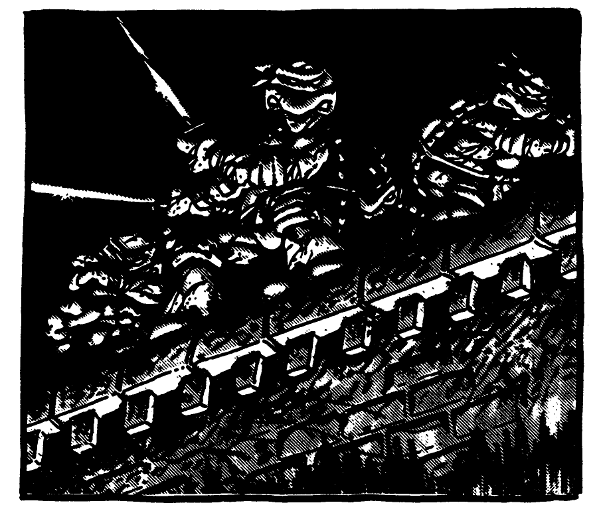
There's also an extensive equipment section I won't really cover; an obsession with surveillance equipment that feels like it was copied out of catalogs, a price list for vehicles and clothes, a section on lockpicks, police equipment, explosives, and a few oddities like jet jacks, magnetic pads for sticking to metal surfaces, and space suits. And, of course, weapons and armor. Characters that are part of a "secret organization" can buy them for listed prices, but most characters have to pay triple prices. Alternately, you can scrounge up equipment for half the price, but with a 14% chance of breakage every time they're used. (As tempting as it may be to save money, don't scrounge up a pair of pants.) A lot of the scrounging rules will be contradicted as well because, well, Palladium.
And that's it for the Palladium system in brief, so we can get to the more interesting parts. It's not as broken as the Rifts system is (with Mega-Damage Capacity, missile rules, and various dodgy subsystems), it is unclear and often contradicts itself. Indeed, some of my above description is a "best guess based on available evidence", but it'll do; I'm not here to nitpick every bit this time around.
There'll be plenty to nitpick anyway.
Next: Making a mutant.
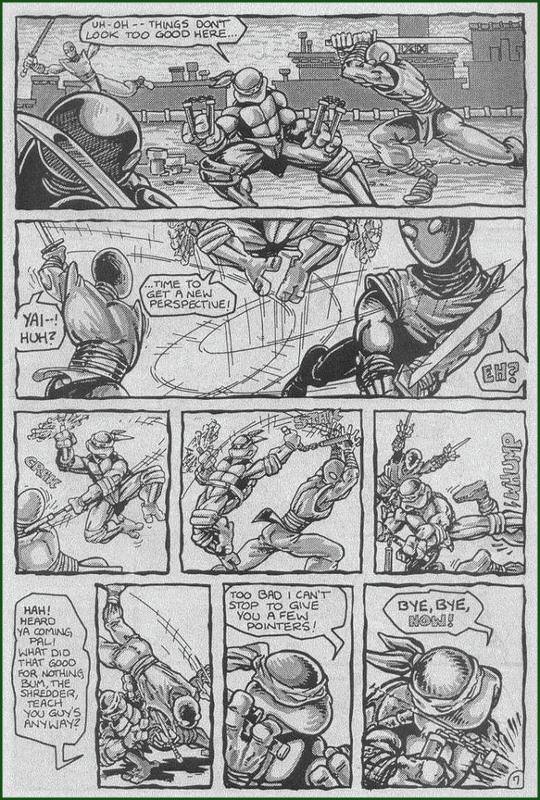
"However, we recommend random determination."
Original SA post
Teenage Mutant Ninja Turtles & Other Strangeness Revised Edition, Part Four: "However, we recommend random determination."
So, with the basic rules out of the way, we can move on to character creation.
First off - even though it doesn't mention this until Step 4, some or all of the players can choose to roll themselves up as a team. That means they all roll and share the same background and animal type, and have to all spend their BIO-E the same way. However, they'll get big bonuses as detailed below.
Step 1: The Eight Attributes
Roll 3d6 down the line. If an attribute rolls a 16 or higher, add an extra 1d6 to it. If you're doing team characters, whenever somebody rolls that extra 1d6, all the other team characters get that added to the same attribute. If multiple people roll that bonus 1d6 on the same attribute, they take the highest bonus rolled rather than adding them together. Attributes that are 16 or higher get a bonus. Hit Points are your Physical Endurance + 1d6 at first level, and an extra 1d6 every level after that.
Step 2: Animal Type
You roll randomly on a set of percentage tables to determine your animal type. However, the gamemaster can restrict certain tables or allow players to choose animal types... but it really recommends going random. The tables aren't heavily weighted - you're more likely to roll a "urban" (pests, pets) animal or a "wild animal" (wilderness) than a "rural animal" (mostly farm animals, but with bat on there for some reason). "Zoo animals" are the hardest to roll up. Some animals are slightly more likely due to appearing on multiple tables (mouse, pigeon, sparrow, duck, bat) but it's very slight. For the record, your chance of rolling up a turtle is roughly 1%.
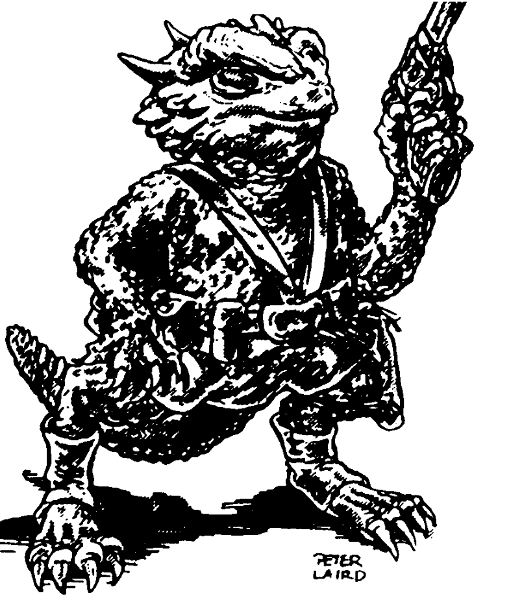
Horny toads actually don't show up for several expansions. Sorry!
Step 3: Cause of Mutation
You roll randomly to figure you your character's mutation cause and resulting background. 14% are "Random Mutations", which means your character is literally just a natural mutation, as ridiculous as that may be. 46% are "Accidental Encounters", which are animals just exposed to radiation or chemical spills or the like. And lastly, 40% are "Deliberate Experimentation", which generally means genetic experiments of some sort.
If you roll "Random Mutation" or "Accidental Encounter" you roll on the "Wild Animal Education Table", of which the highest chance is being adopted by a mentor (literally a 50% chance, so 30% of total characters written up will end up as ninja, appropriately). There's a 20% chance of being a feral wild creature, a 20% chance of being a homeless mutant animal, and a 10% chance of - very curiously - going public and being taken in by a university as a student!
"Deliberate Experimentation" characters roll on the a much longer table, with about a 30% chance of having been raised as a pet with varying reactions and acceptance, 30% chance of being adopted and raised by the organization as a specialist or as if they were human, 20% chance of being raised cruelly as an experiment, 10% chance of escaping with a researcher that raises one, and a 10% chance of being deliberately raised as a soldier. We get a roll or the type of organization, of which only 25% are actual biological research firms and 30% chance of being part of some secret organization.
Once you have the cause of mutation, you'll also know the skills you have to select and the amount of money you get for equipment.
Step 4: BIO-E Points
This is where you "build" your mutation, which I"ll cover in the next part.
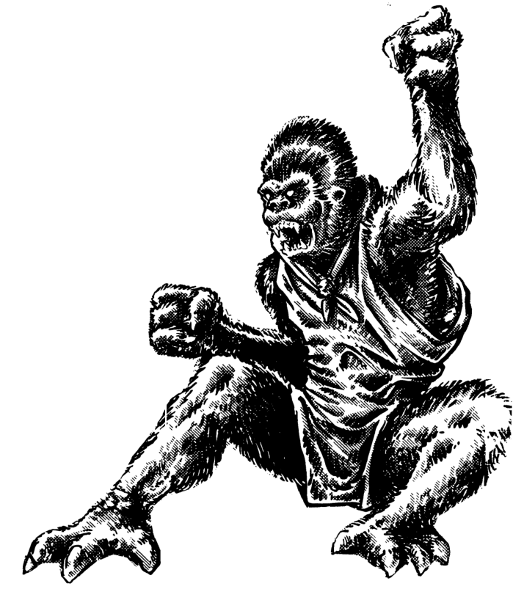
Step 5: Equipment and Money
Here you turn to the equipment list and go shopping. Despite the above rules for scavenged equipment, we're told "the reliability of character built equipment is equal to the character's skill level", which presumably refers to electronics or mechanical skills for it... but it's hard to say.
Rounding Out One's Character
You choose an alignment; these are the same good, selfish, and neutral alignments found in every Palladium book and have no mechanical effect outside of the See Aura power. There's an additional diatribe talking about how some characters may be anti-heroes or vigilantes and be largely selfish or good respectively, though it notes some more extreme ones may be downright evil. We get the "no neutral alignments" section as always: "Sorry, no neutrals; this is one of the very few definitive, unbending rules of this game."
We get rules for XP, but because it just starts at 0, we can move on.
Oddly, at the end we get skills. Depending on your cause of mutation, you may have individual skills to pick from specific categories or "skill programs" which are usually fixed sets of skills representing a collegiate-equivalent education. You may also have "secondary skills", which are chosen from a small subset of the larger skill list and usually don't include "professional" skills. I won't get deep into these save to say there are three types:
- Normal Skills have a starting percentage chance of success that increases each level at a rate depending on the skill. Sometimes there are different percentages depending on the task.
- Physical Skills often (but not always) give a bonus to physical attributes or combat but have no percentage success of success. Other physical skills work just like normal skills. Some provide both bonuses and a percentage chance of success on a task. It's confusing.
- Hand to Hand skills give bonuses in combat.
- Ancient Weapon Proficiencies give bonuses in combat when using a particular weapon.
- Modern Weapon Proficiencies let you take the standard bonuses when firing a gun aimed and the like.
Mind, the actual Ninja Turtle statblocks will defy these character creation rules, which is curious given that they're treated as playable characters... but we'll get to that when we get to them.
Next: Origin of the species.
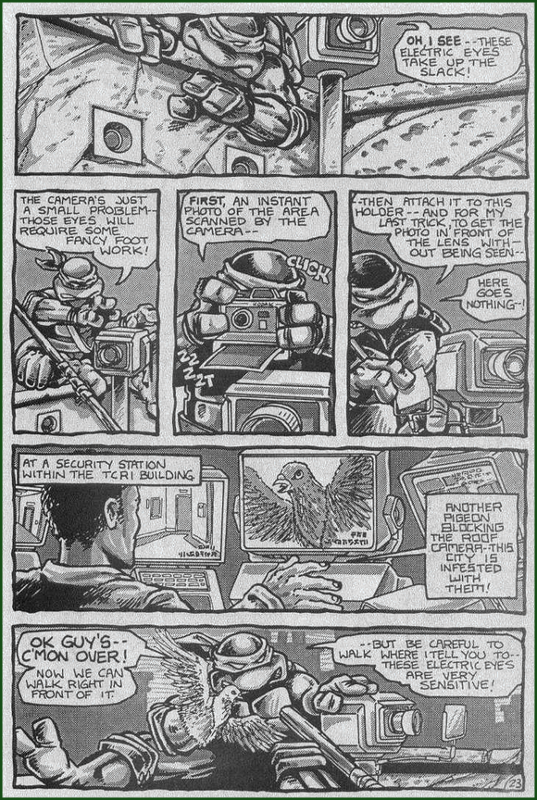
"Real mutation almost always results in death or disfigurement."
Original SA post
Teenage Mutant Ninja Turtles & Other Strangeness Revised Edition, Part Five: "Real mutation almost always results in death or disfigurement."
BIO-E Points
Time to find out how to mutate your animal! After working out your animal type, you cross-reference it with the list of animals to find out several things:
- The BIO-E points you get to spend, if any. This can be 0.
- The size level of your base animal, rated from 1 to 20.
- The attribute bonuses for your animal type. These are added directly to your attributes, as determined earlier.
- The cost it takes to purchase human features, and grow closer resembling a hairless ape.
- What natural weapons or animal powers you can purchase, if any.
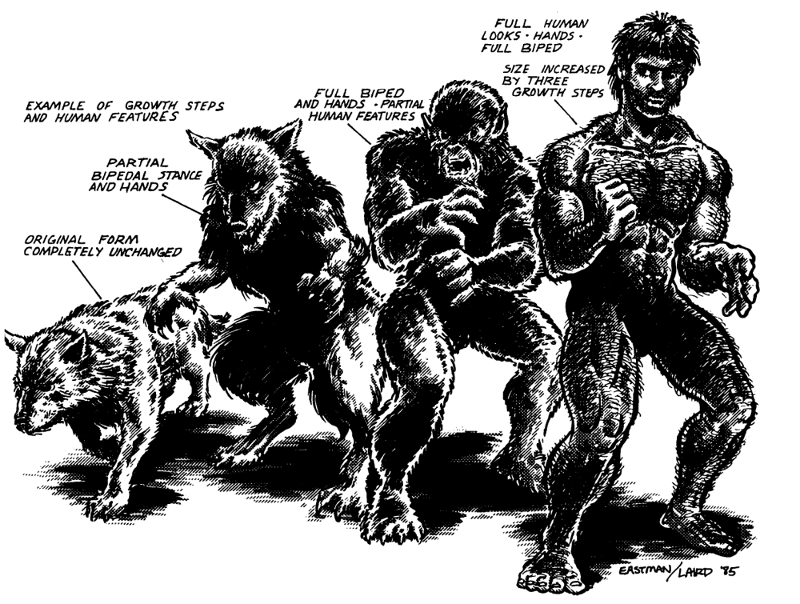
Man, Wuj, nobody wants to play a mutant animal that just looks like some guy!
The second thing to look at is human features. These come in four categories of three steps each. "None" means the feature is just like that of your natural animal type. "Partial" means you're halfway between animal and human in that category. And "full" means you're functionally human in that category. The four categories are:
- Hands: At partial, you have fingers and a non-opposable thumb, and can wield weapons and use appropriate skills at severe penalties. At full, you have a fully working set of hands.
- Speech: At partial, you have a rough, bestial voice that people can become accustomed to understanding, but strangers will have a harder time. You know, like Scooby-Doo. Full means you have a fully intelligible voice.
- Biped: At partial, you can start like a bear does, but move at greatly reduced speed and can't run, jump, or kick while standing. Full means you stand up just like a human does.
- Looks: At partial, you look human-ish, and can pass for a human in bad light or with a mask on. At full, you look kind of weird, but close enough to pass for human.
Another thing you can spend BIO-E on is animal powers. These come in several general categories:
- Natural weapons like claws, teeth, tusks, horns, or antlers, doing between 1d4 and 2d12 damage. Since any animal can pick up a weapon that does equal or more damage (presuming you picked up hands), these tend to be a waste. The only advantage to a 1d4 or 1d6 claw over a 1d4 punch or 1d6 kick is the fact that they can't "roll" with your hits to reduce the damage.
- Natural body armor that acts just like regular armor, only you can't take it off. Often comes in different grades
- Movement powers like digging, tunneling, excavating, swimming, floating, flight, and gliding. The latter two give bonuses to dodge and damage while in midair.
- Heightened senses like advanced vision, hearing, smell, or touch, as well as nightvision or ultraviolet vision. Smell lets you track, hearing gives an initiative bonus, and touch gives a small bonus on certain kills, but other senses are just descriptive.
- Oddities like extra limbs for bird mutants to have both arms and wings, or the ability to hold breath longer than normal. (It specifically notes just because you can hold your breath doesn't mean you can swim; the skill must be purchased separately.) There are also unique powers for various animals like an alligator's quick run, a duck's water repellent feathers, a camel's spit attack, a cheetah's heightened speed, an opossum's play dead, a porcupine's quill defense, a weasel's increased metabolic rate, and many others.
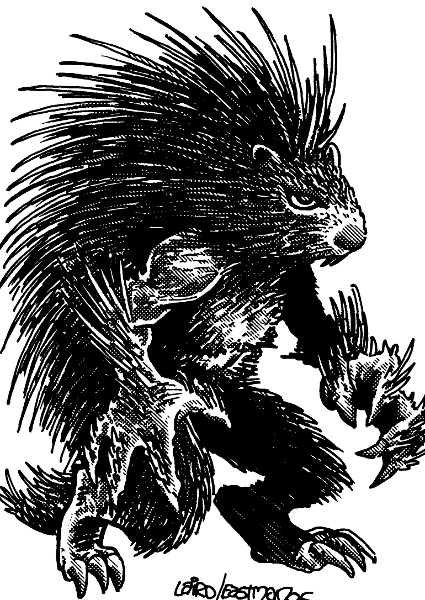
Sonic looked way cooler when he was still a porcupine.
The last and weirdest thing you can spend your BIO-E on is psionics. Why this game includes psionics is a mystery to me - the Teenage Mutant Ninja Turtle comics have very little that can be described as such. Indeed, magic and super-science are a lot more common. While there will be a one or two obscure psychic characters later on, none have shown up at this point in the comics. It seems largely here to give some animal rapport powers and to enable some psychic mind control NPCs later. For those familiar with other Palladium games, note that the powers here don't have any limits on usage like "Inner Strength Points" - you can use them as often as you like. The powers available are:
- Animal Control: You can psychically control animals of your type - and specifically only your specific type. So if you're a mutant tiger, you can control tigers, but not lions, leopards, or tabbies.
- Animal Speech: This lets you communicate with animals... specifically, once again, only of your specific type. A mutant dog can't psychically connect with a wolf.
- Bio-Manipulation: This is a psychic attack that lets you inflict various status effects: blind, deafness, mute, pain, paralysis, stun, or tissue manipulation. Each is bought separately and have the same costs, and as you may guess, paralysis is ridiculously better than most of the others. Tissue manipulation, on the other hand... you just spent 20 BIO-E on the ability to make somebody become itchy... some of the time. Congrats.
- Detect Psionics: This gives a 75% chance to detect another psionic, unless they're mind blocked.
- Hypnotic Suggestion: This lets you give commands unless they're "completely out of character". Specifically, no suicide commands unless the person that wants to die.
- Mind Trap: Lets you trap somebody in an elaborate psychic illusion and renders them effectively helpless, but requires the user to keep some level of vague concentration. It presumes this is used for abuse or torture (and not, say, therapy), and gives optional rules to inflict permanent insanities if you have a copy of Heroes Unlimited.
- Mind Block: An absolute defense against psychic attacks while in use, and just psychic communication in general.
- See Aura: Shows you the alignment, species, and "estimated level of power" of a target.
- Sixth Sense: This gives you a spidey-sense - a sense of danger but not what is occurring. Provides no actual mechanical bonus against being surprised.
- Telepathic Transmission: Lets you psychically communicate. Cheaper than talking, at 5 BIO-E, but I guess it limits your ability to use phones. It notes "You can't use this to READ anything.", which... okay?
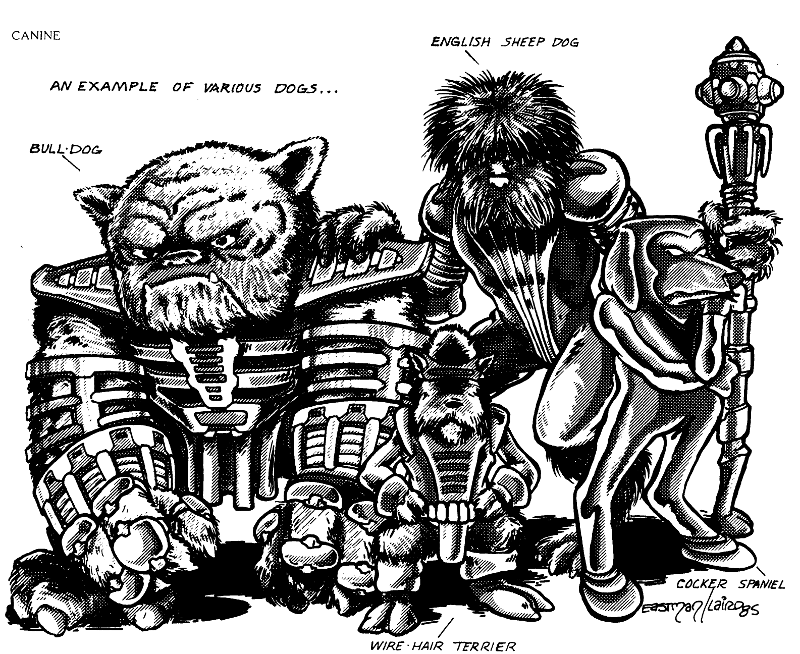
And for some reason, dogs as the heralds of Galactus.
Lastly, there is an actual formula that generally determines the BIO-E available to a given animal type! I know! It's shocking! The formula we're given by Wujcik is:
pre:
50 - (Size Level x 5) + (Cost for full human features) - ([# of attribute bonus categories] x 5) = Total BIO-E Where "Total BIO-E" cannot be less than 0.
pre:
50 - (11 x 5) + (5 + 5 + 10 + 5) - (6 x 5) = -10 BIO-E
pre:
50 - (Size Level x 5) + (Cost for full human features) - (total attribute bonuses, rounded to the nearest increment of 5) = Total BIO-E Where "Total BIO-E" cannot be less than 0.
pre:
90 - (11 x 5) - (10) - (15) = 0 BIO-E
- Because this is a Palladium book, some are just wrongly counted, like cows and bulls. (Also, bulls are just better than cows, getting attribute bonuses where cows get none. Sorry, cows.)
- Dogs are particularly badly done, where they have a variable size level, but that size level is wrongly accounted for, meaning dogs above size level 5 are penalized by around 5 BIO-E per size level.
- Since there's no "negative BIO-E" values for animals, large animals like elephants basically get free size levels, which ultimately results in them getting more BIO-E than other animals.
What's missing are nearly any reptiles (turtles only) or amphibians (frogs only). In addition, fish and marsupials are missing entirely, as are any invertebrates. More animals will be added in supplements, mainly through the After the Bomb setting. So if you were interested in seeing more animals, you unfortunately had to invest in that setting, as they drip-fed them largely in those supplements rather than the main Teenage Mutant Ninja Turtles, which... I don't know if it was an intentional way to push that secondary setting, but it was an effective one. I mean, maybe you're not interested in animal Camelot (aka Animalot) or post-apoc Yucatanimals settings? Well, we've got some new animals for you in those books anyway...
Next: Hey, kids! Biff! Pow! Comics!
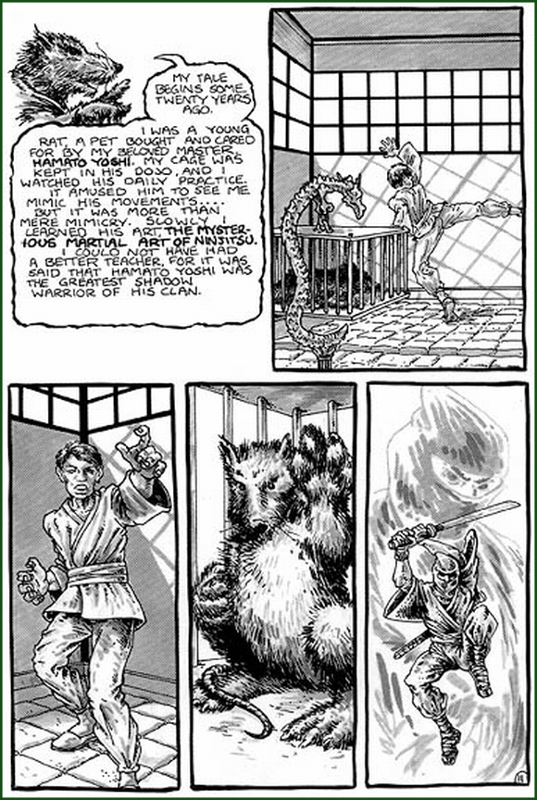
"I hope everybody buys the story that they're my southern cousins."
Original SA post
Teenage Mutant Ninja Turtles & Other Strangeness Revised Edition Part Six: "I hope everybody buys the story that they're my southern cousins."
So, one of the interesting parts of the first few Teenage Mutant Ninja Turtles and Other Strangeness supplements is that each one had a mini-comic done by the actual Teenage Mutant Ninja Turtles creators, Kevin Eastman and Peter Laird. What's more, they were largely only available through the RPG books, so if you were a fan of the comics, this was the only way to read them. Nowadays you can get them through IDW's Turtles collections - the Teenage Mutant Ninja Turtles Ultimate Collection Volume 6 collects all of the Eastman & Laird stories that were in the Palladium RPG books (though not the Walter Storozuk story from the Road Hogs supplement).
It shouldn't be understated what a coup it was for them to get art by Laird and Eastman throughout the book, as well. Though it's common for licensed comic RPGs to use art provided by the publisher, only a few have had art by the original creators (other notable examples would be the Nocturnals supplement for Mutants & Masterminds or the Atomic Robo RPG). Whether or not it's valid, it gives the RPG a feel of authenticity that few licensed RPGs have. And it wouldn't just be a one-off - the first three supplements would have art by Laird and Eastman, and later supplements would have art from Jim Lawson, who would later go on to become the regular artist on the Turtles comic itself.
As for the story itself, the turtles are getting ready for a Halloween party at the apartment above April's second-hand shop...
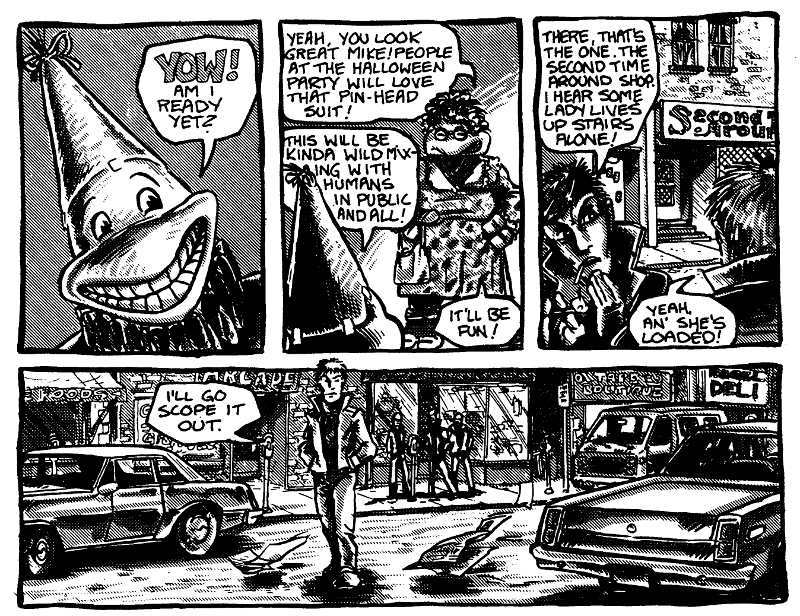
... when a bunch of thieves break in to rob the place.
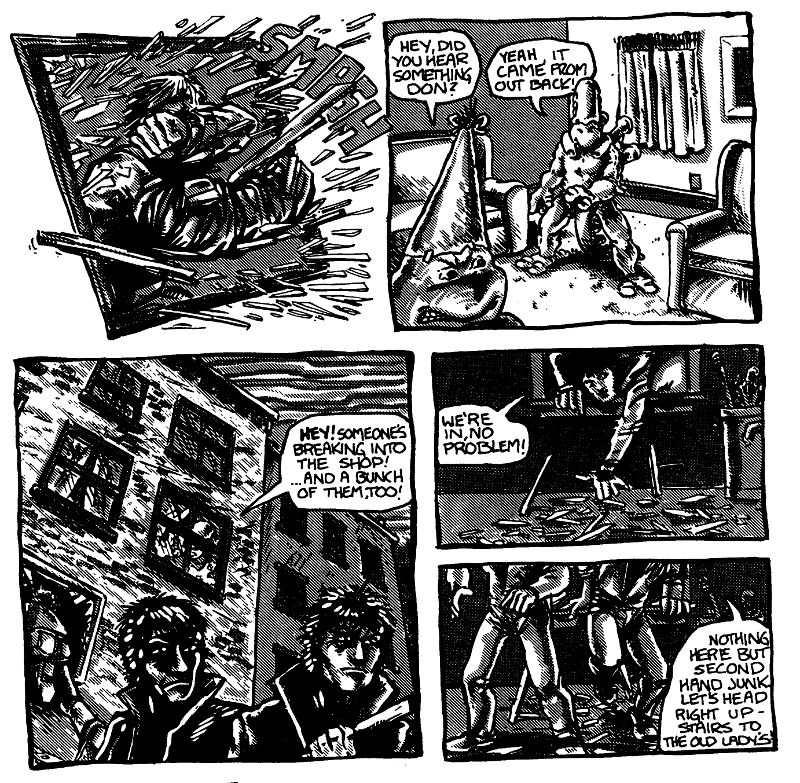
Needless to say, the turtles kick the shit out of them for it...
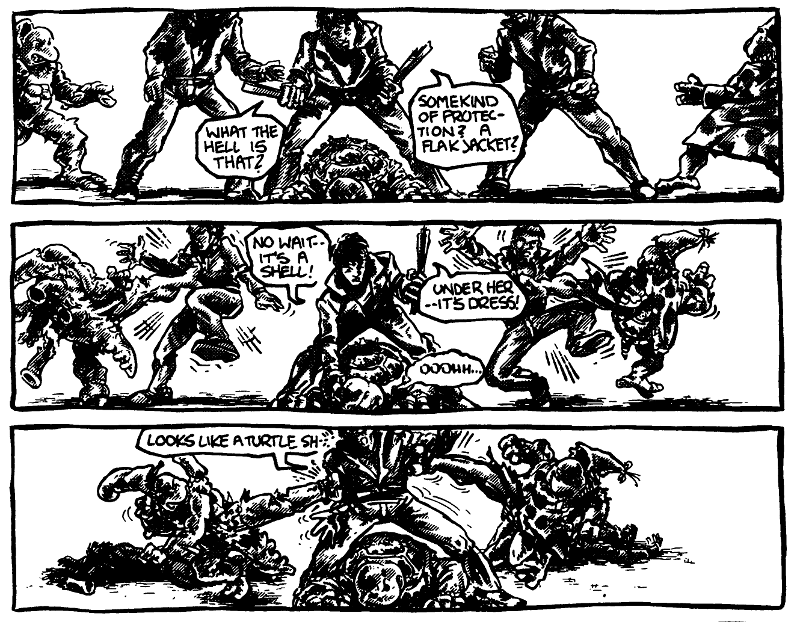
... but their costumes are ruined.
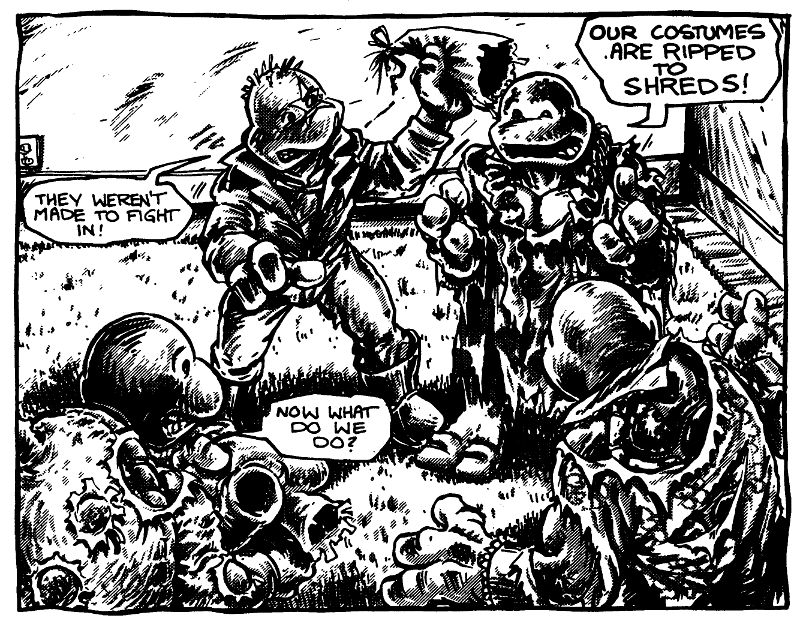
And so, they go with the simple solution and obvious punchline.
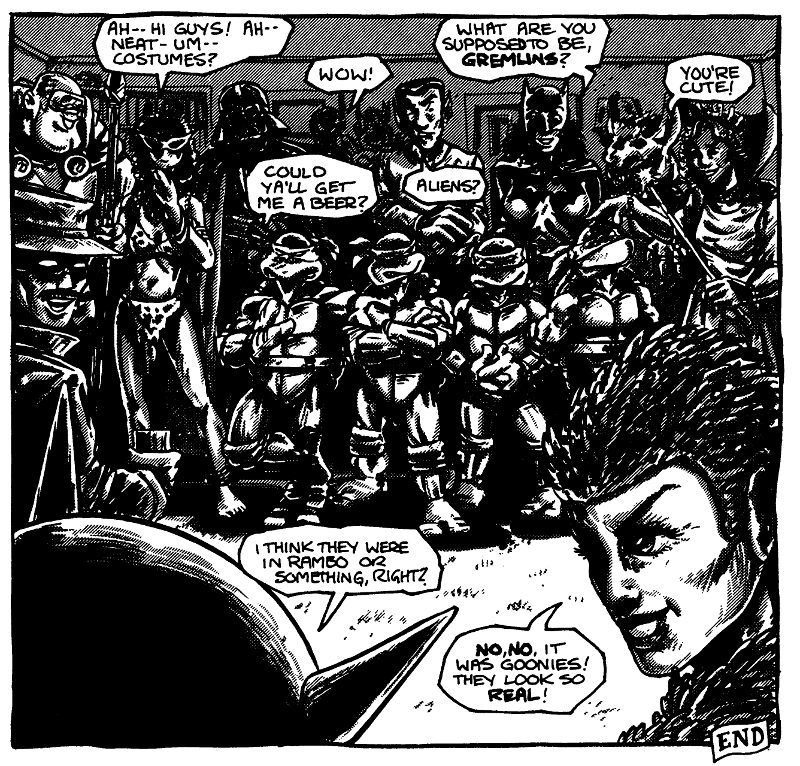
It doesn't really tie into the game itself, but it's a cute extra to have.
Next: How (not) to run a role-playing game.
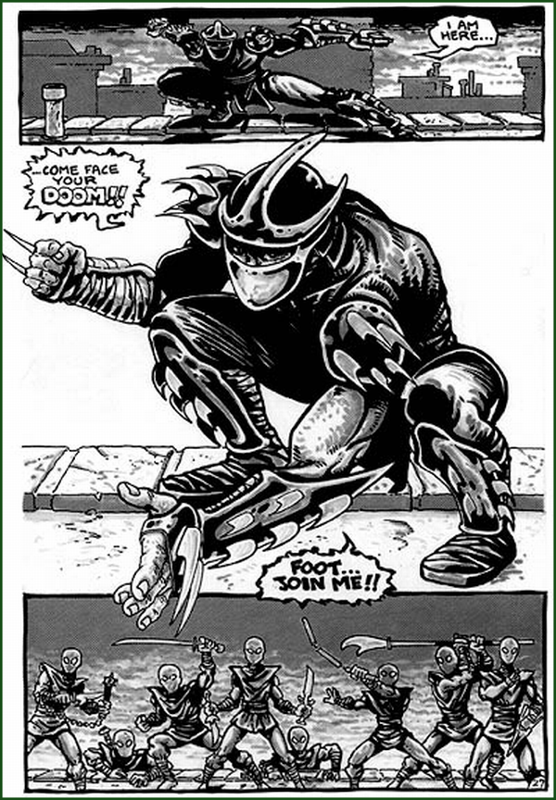
"First of all, the most important thing that a player can do is PLAY IN CHARACTER."
Original SA post
Teenage Mutant Ninja Turtles & Other Strangeness Revised Edition Part Seven: "First of all, the most important thing that a player can do is PLAY IN CHARACTER."
Game Master Section
So, we get a Game Master Section, where Wujick emphasizes the need to run an enjoyable game. Beyond selecting or creating an adventure, he emphasizes three points:
- Make sure the adventure is challenging but not too frustrating. How do you do that?

- Make sure each character has a chance to use their key skills and powers.
- Make sure the scenario fits the motivations and alignments of the characters.
- XP should be primarily given for playing in character and sticking to their defined personality, whatever that might entail.
- After that, reward those who think cleverly as a player, whatever that might entail.
- Lastly, he says that you should never give XP based on friendship and only the performance of the player.
Teenage Mutant Ninja Turtles and Other Strangeness posted:
Just consider, if you were keeping score in a card game, would you give more points to your buddies? No one GETS experience points, they EARN them by playing in character and using their wits.

Lastly, we get an extended note on how NPCs shouldn't fall into stereotypes and should have personalities that make them memorable.
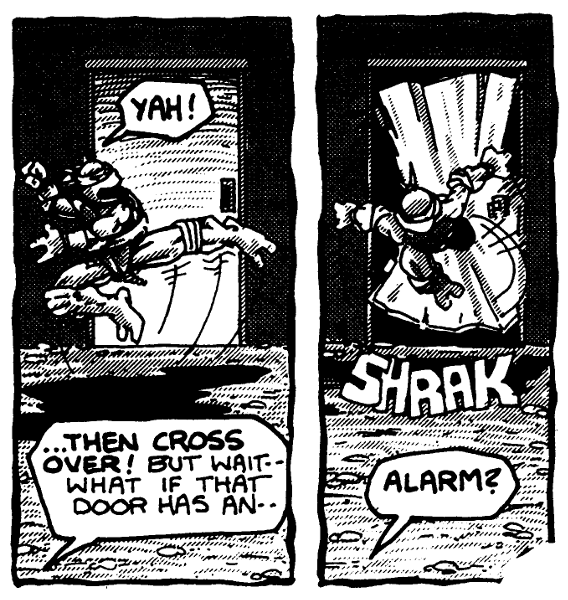
Adventures
We get some random roll tables for villain alignments, villain objectives, villain associations, and creating criminal organizations. He suggests you can use natural disasters ripped from the headlines as adventure fodder, that danger and tension are important to engaging players, and that adventures should require thought and investigation instead of just being wandering monster encounters. We get a sales pitch for Heroes Unlimited and Ninjas & Superspies as ways to upgrade your game, because this is still very much a Palladium book, and he also has optional rules for adding mutant animals to the random roll charts for Heroes Unlimited - which is problematic, because most Teenage Mutant Ninja Turtles and Other Strangeness characters are notably weaker than heroes that can set themselves on fire or are loaded down with plasma cannons... but Heroes Unlimited is a game without any real balance to begin with, so maybe it's a wash?
Teenage Mutant Ninja Turtles and Other Strangeness posted:
You could run a game where the players actually run the characters of Raphael, Donatelo, Michaelango and Leonardo. While this is NOT recommended for any kind of extended campaign, it would make for a lot of fun in one-shot scenarios.

Granted, using them at all kind of highlights the Turtles themselves weren't made using the actual mutant rules, but... we'll get to that. Speaking of which, we also get the formula (which, as stated earlier, is incorrect) for making new animal types, using kangaroos as an example.
It's a decent GM section... for its time. But by modern standards, it's awfully meandering, a kitchen sink of ideas without much focus.
Next: Strangeness.
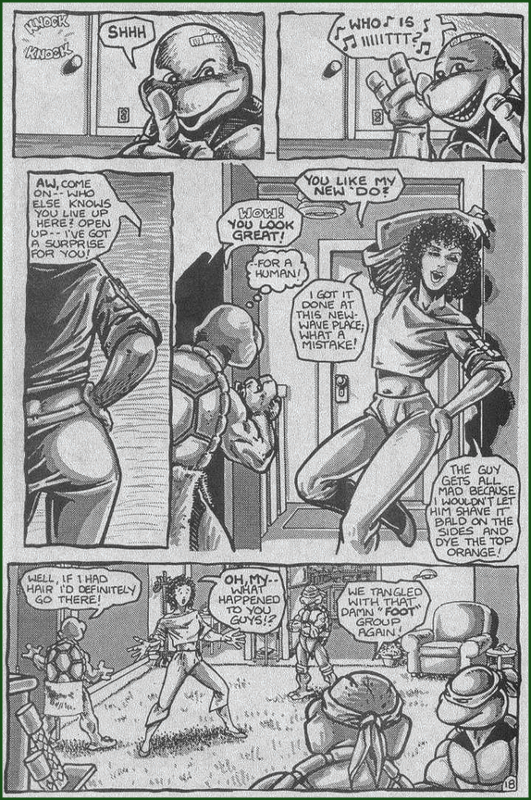
"They'll simply kill everything that gets into their way, because they know they will need food soon."
Original SA post
Teenage Mutant Ninja Turtles & Other Strangeness Revised Edition Part Eight: "They'll simply kill everything that gets into their way, because they know they will need food soon."
This is where things start getting weird. It's time for some adventures.
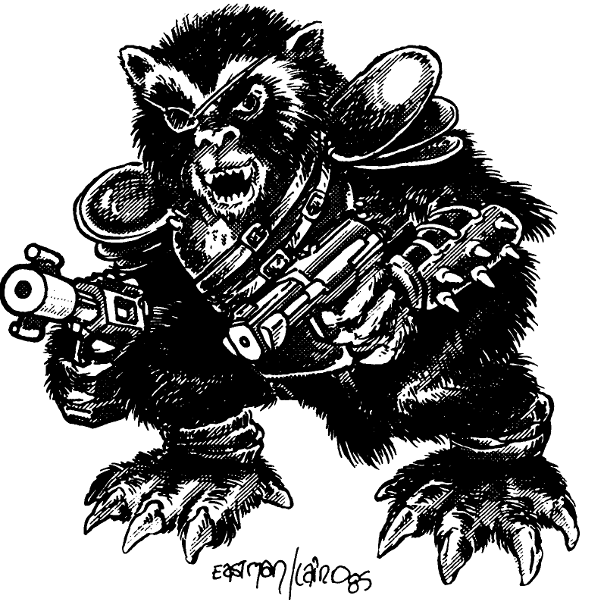
Caesar's Weasels
So, we start with a mutant wolverine named Caesar, who apparently was created as a "secret laboratory experiment", and escaped along with several other mutant animals. What laboratory created him is undetailed, despite that fact likely being of keen interest to a group of vigilante mutant animals. Instead, the focus is on the fact that Caesar and his fellow mutants have turned to thievery, and it's presumed the player characters will want to stop him because they do. Caesar & Co. are mainly looking to steal two things: food and weapons. After six weeks, they plan to take a train north and take over an isolated community. Caesar apparently has very modest dreams of conquest, despite his name. "Cisely, Alaska... will be mine!"
There's no strong structure to the "adventure" - it's more like just a series of events for the PCs to investigate and stop. It starts with stories involving raids on meat packing plants that apparently have been going on for six weeks. After a few days of (fruitless?) investigation by PCs, there'll be another story of a military break-in. The police don't have any clues, but on the rare chance the PCs have access to military contacts, they may be able to find out what was stolen. However, Caesar's titular weasels require an extraordinary amount of food due to their heightened metabolisms, so the PCs can recognize that they raid for food every week and stake out a meat packing plant or the like to ambush them.
Caesar and his crew are hiding out in a refrigerated train car due to be shipped north in six weeks. It notes that smart PCs should be able to figure out that Caesar needs a place to store all the meat, but there's no easy wait to track down the train car - it even specifically notes that Caesar has hacked the database and falsified the railroad company's information on the train car. In addition, it's electronically bugged, locked and, "wired with explosives". In addition, they have a backup hideout at an abandoned warehouse. If they encounter the PCs more than three times, they will flee into the wilderness to regroup before coming up with a new plan. It's up to the PCs to navigate the myriad possibilities for failure and stop them.
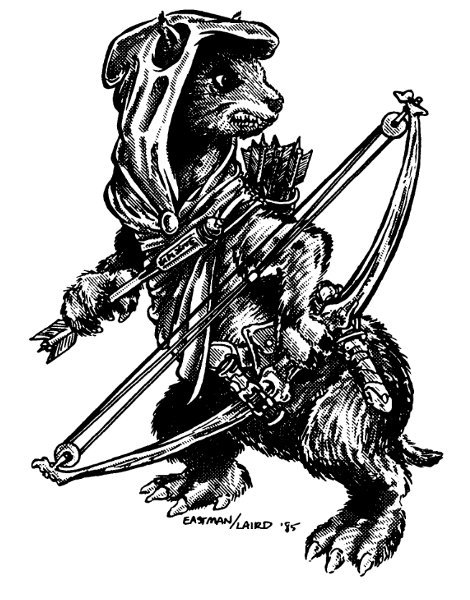
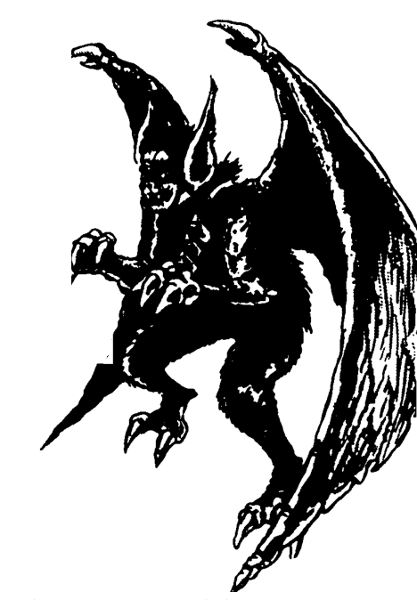
Caesar is a 6th level military trained wolverine with ridiculously unrollable attributes, a variety of guns and body armor, an a villainous lust for generic power. He hates humans due to the brutal training he underwent (the missing eye being the pointed part). The 4th level weasels are named Tork, Hambone, and Lyssis, and are childlike, amoral killers that use bows (including some explosive warheads), and rely in Caesar's guidance. Without his guidance they would probably just run wild. T'Cleass the Bat-Thing is the weak link, being a "kill-crazy" idiot mutant bat that is constantly flying off the handle. Somehow he's 6th level despite having little or no apparent education or experience at much of anything.
This is a rough adventure, and a real bad one for starting NPCs. For one, weasels are probably one of the premier killamajigs of the game, heightened metabolism giving them bonus attacks and great combat bonuses across the board. Secondly, Caesar and his group likely have 2-5 levels on any group of starting PCs. If it comes down to a pitched battle, the PCs could easily probably lose to this well-armed group that has no reason not to just kill them... unless the PCs have psionic attacks, since that'll reliably be able to shut down any member of the group. Lastly, there's no cue to the PCs that they're dealing with ruthless killers until they actually encounter them, at which point they may have to find out the hard way.
There's also kind of a pattern of the PCs having to face up against the victims of abuse rather than the perpetrators of abuse, which we'll see in...
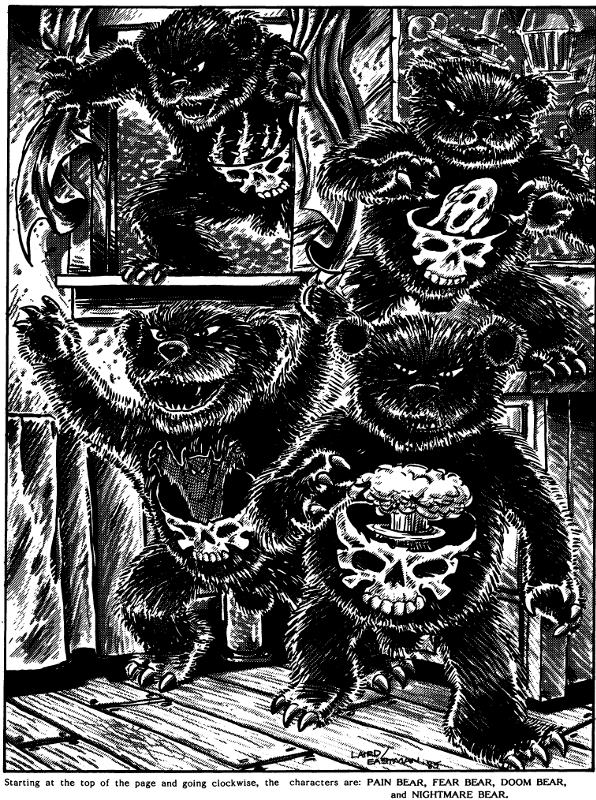
The Terror Bears
So, the terror bears are four bears mutated by military attempts to test viruses and toxins. However, they didn't actually kill the bears despite "massive doses of poisons", as the scientists wanted to "measure their suffering". Ooookay. They then discovered the bears had achieved unusual intelligence, and then went to "even more brutal experimentation". Finally, the bear cubs (still cubs after 4+ years, presumably on account of their mutation?) escaped and took refuge in a suburban home. They've been robbing for money and food since then, using formidable psionic powers to terrify and traumatize their victims. Bizarrely, they go around using hats and coats to "disguise" themselves despite each of them being about three and a half feet tall.
Once again, the adventure presumes PCs are ready to deal out some vigilante justice. It notes that it should be easy enough to catch them in the act as all of their robberies have occurred in about an eight mile radius, or to track them back home. Locals have been psionically manipulated to fear and stay away from the house (whatever happened to the original inhabitants, if any, is not detailed), and the bears themselves have turned the house into an undetailed "bizarre den", operating nocturnally and sleeping during the day. The bears are terrified of being captured and will flee if threatened. They're not killers, but enjoy torturing humans psychically. It's emphasized, however, they are children and are reacting in an immature and amoral manner and not out of calculated menace.
There are four bears. First is Pain Bear, who can psychically inflict pain and trap victims in illusions of torture sequences. He loathes everybody, particularly himself, and lashes out for a feeling of power. Fear Bear can (somehow) use See Aura to intuit somebody's fear before trapping them in a psychic illusion of the same. He really hates humanity, but mostly just follows Doom Bear. Speaking of which, Doom Bear is convinced a nuclear war is coming, and his illusions trap victims in simulations of nuclear war. Lastly, Nightmare Bear is the leader and the only one with real forethought, acting as the caretaker of the others. He can use Mind Trap (somehow) to create illusions relating to one's past traumas and nightmares. A little overlap between Fear Bear and Nightmare Bear, really.
Did I mention this section was going to be weird? I mean, what are the PCs supposed to do? The bears will lose their shit at the thought of capture, aren't easily redeemed, and otherwise they're gunning down a number of psychically sadistic teddy bear children. The whole thing is a little problematic in retrospect, and it feels weird that the idea of going after the villains that created and tortured the Terror Bears doesn't even come up. (And, yes, they're rather pointed parodies of the Care Bears... if you haven't noticed already.)
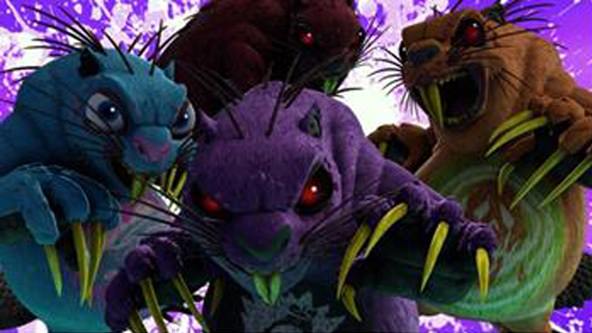
Even more strangely, the Terror Bears are one of the few RPG elements with a life after the RPG. A 2014 episode of the cartoon features the "Dream Beavers", otherdimensional psychic creatures that try and invade the Turtles' dreams to cause enough fear to manifest in our reality. One of them, Dire Beaver, even has a bomb on his chest and was originally named "Doom Beaver" until presumably some Nickelodeon employee worked out that might be a little too close to Doom Bear. There are even two toys of them, giving me one of the few times I can say a multimillion dollar toy line ripped off a Palladium product... and Nightmare on Elm Street... but also a Palladium product.
Next: Other strangeness.
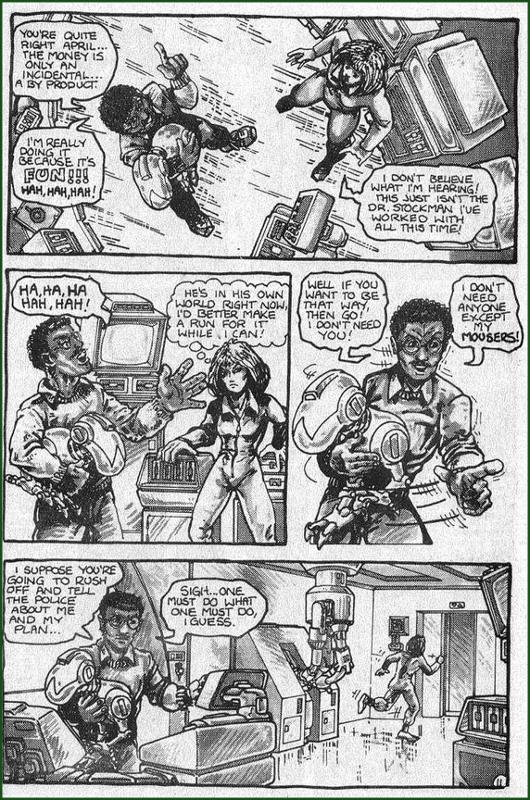
"He does not allow racial or sex discrimination in any of his businesses, he condemns dictatorships or racist behavior, he is generous with friends, employees, educational institutions and the poor."
Original SA post
Teenage Mutant Ninja Turtles & Other Strangeness Revised Edition, Part Nine: "He does not allow racial or sex discrimination in any of his businesses, he condemns dictatorships or racist behavior, he is generous with friends, employees, educational institutions and the poor."
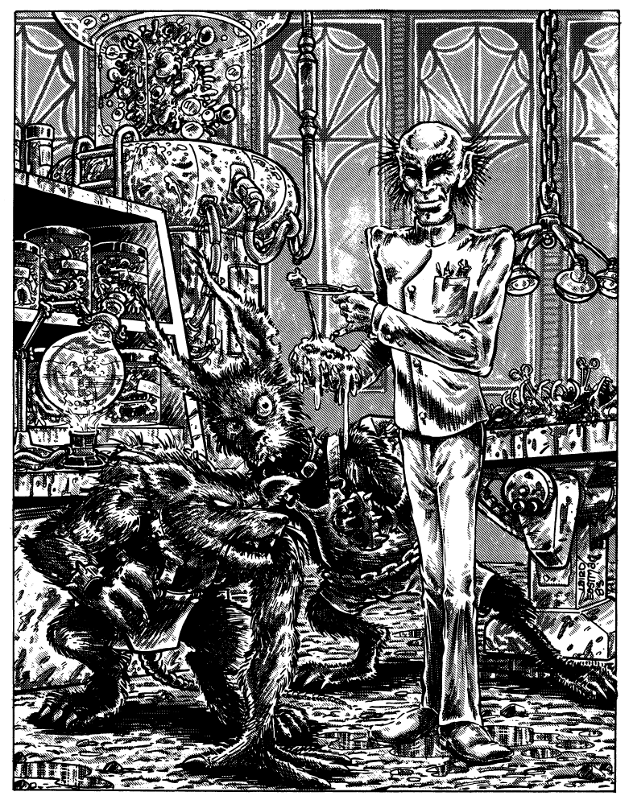
That can't be sanitary.
Doctor Feral: The Genius of Bio-Spawn
Though billed as an "adventure", this is more just a really detailed antagonist writeup with some vague hooks.
Dr. Victor Oban Feral is a brilliant scientist and the head (no title is given) of a company known as BIO-Spawn. Feral is an ideal corporate citizen; his businesses are progressive, banning sexual or racial discrimination, he refuses to deal with those he finds ethically bankrupt, obeys both the spirit and letter of the law personally, and makes generous donations to charity. He more or less has the police in his pocket. He claims to be on the cusp of developing an "immortality drug" and has a number of wealthy and powerful patrons as a result. The catch is that he's massively racist towards mutant animals, not really considering them anything more than slaves or test subjects. In addition, he's obsessed with studying them scientifically. Why?

Of course, this being a Palladium book, it wants to give him the alignment of "Scrupulous" (aka Neutral Good) despite his tendency to torture or vivisect mutant animals, which doesn't follow. If I take care of orphans in my spare time 29 days out of the month, and then 1 day a month murder somebody in an excruicating fashion, my good deeds to not obviate the bad deed.
It notes that the PCs are likely to encounter him by direct invitation if they're out in public, and he will make attempts to invite others to his home, where he will politely offer hefty cash payments for blood and tissue samples. Afterwards, he will contact his hired goons to attempt to shadow and kidnap them later. However, he will never personally involve himself in combat or illegal activities. Because of his pull, any dead or captured mutant animal will likely be handed over to him by the police. Lastly, he has a number of mutant animal slaves which he controls via shock collars that can cause suffering or death. A number of staff members are detailed who are all unswervingly loyal and generic.
His main animal henchman is Otto Rattus, a mutant rat who originally was a pet of Feral's, and the only one not to wear a collar. He's been surgically modified to look (mostly) human, and is unswervingly loyal of Feral and paranoid regarding those who might threaten him. He's partially bionic, mainly in the form of replacement organs made by Feral to increase his lifespan. He has a ridiculous and superhuman Physical Strength of 34, which would require near-perfect rolls for a PC to achieve.
Karl is a mutant rabbit who acts as Feral's chief assistant. He's a brownnoser and sadistic, though he secretly hates Feral and would very much like to escape. He tries very hard to fake being smarter than he is, but not too much, as apparently Feral has a tendency to vivisect any animal he finds curiously intelligent.
Lastly, Igor is as short white rat with only partial human hands, biped, and speech features. He's psionic (with Hypnotic Suggestion and Detect Psionics) and works to make sure other psionic creations are destroyed. Like Karl, he enjoys torturing other animals, because we can't have any of Feral's creations being slightly sympathetic.
We're told he also have "special purpose Combat Animals" based on rats, mice, or rabbits designed specifically to take on other animals, but they're undetailed. We also get details on BIO-Spawn's vans they use for mutant animal kidnapping, or to take on wounded or dead animals taken by the authorities. The control collars are also detailed, as well as an extensive listing of the multimillion / multibillion dollar companies BIO-Spawn has a stake in.
Feral is a decent idea at heart for a game like this, but the ham-handedness of the "Is he really such a bad guy, makes you think huh?" routine and, once again, being made to fight the victims of abuse is... a recurring theme. In addition, the near-universal loyalty he seems to inspire in anybody he winks at gets pretty wearisome; you'd think his activities would start to draw some scrutiny, especially with his white-furred animal death squads. Well, hope you like him, because he shows up in the majority of core supplements...
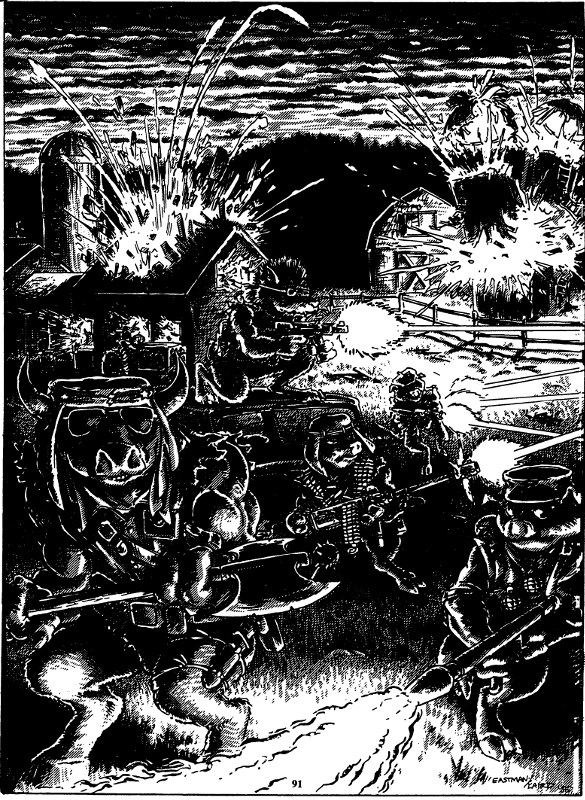
Terror on Rural Route 5
So, eighteen years ago, a farmer named George Boswitch struggled to maintain his family farm. When he bought load of "bargain" feed, it turned out to be laced with a chemical that killed all of his animals. However, before they died, several animals gave birth. He was able to support himself with the resulting settlement from the feed company, but the baby animals that survived started developing strange human-like characteristics. One of them was Ferd, a mutant bull who discovered that George was going to sell them to a circus at an early age. Ferd turned out to be a hypno-bull, and was able to brainwash George into holding off on his plan indefinitely. He and the other growing mutant animals were largely taught about the world by TV, and have difficulty distinguishing fiction from nonfiction. When George died, they hid from local officials evaluating the property, and when they heard it was torn down, they decided they needed to take hostages to survive. So, a number of them armed themselves and went to the local rural school, taking nearly a hundred children hostage and a half-dozen teachers.
The news will report that "an unidentified group of terrorists" have taken the school hostage, though the police quickly become aware that they're dealing with mutant animals. A figure known as "The Liberator" - that's Ferd - demands a live news conference just in time for the evening news, where he'll issue his additional demands: 6 million in cash, two helicopters with pilots and transport to a "remote northern location". If his demands are not met, he'll start killing a child every hour in the morning. Later that evening, he'll release 16 of the kids. It makes it pretty clear that if threatened directly, the farm animals will pull the trigger.
The irony of an adventure in which dozens of children could die in a property that would soon become a massive, decades-long kids' franchise is thick.
Teenage Mutant Ninja Turtles and Other Strangeness posted:
The situation calls for Ninja stealth and infiltration...
Good thing the PCs are ninjas!... they are ninjas, right? You guys all decided to roll as a group? And got the 30% chance of being ninja? Or are playing the Teenage Mutant Ninja Turtles? Well, the adventure says "Just about any number or level of players should be able to handle it." Hope they all picked up the Prowl skill, at least... In any case, this isn't the sort of adventure with a defined structure; it's a sandbox where the PCs wander in and try and save some kids on a sneaking mission. As such, we get a very basic layout of the school, how it's being guarded, and the antagonists. So let's go over them.
Ferd is their aforementioned leader, a mutant cow with a high strength and mental endurance. He's mostly driven to protect the other animals, but is willing to go to extreme lengths to do so, obviously. He has cow looks with partial speech and hands, is a full biped, and has bull burns. His main weapon is an axe, but he's got a revolver and grenades. He'll be in an office in the school with several kids, along with one of his pig underlings. Oh, and as mentioned, he has hypnotic suggestion as a psychic power.
Buck is a agile hound dog mutant who's his main lieutenant, and calls the old cartoon character Droopy to mind. Apparently he used to keep an eye on things by pretending to be a normal dog; apparently, people didn't notice his freakish near-human hands. He's got full hands and bipedalism, as well as advanced smell, but only partial speech and still looks like a dog. He was actually against the hostage idea, but has been brought over by Ferd's mind control. He's patrolling the school hallways and looking out the windows with two of the pigs every 15 minutes. "Hello there, happy people, it's time to kill some children."
Three of the pigs are watching over the rest of the kids. The pigs are presented in the ugliest possible light:
Teenage Mutant Ninja Turtles and Other Strangeness posted:
... all the pigs at the school are pushy, egotistical and loud creatures who argue about whether or not everything will come out all right.
Teenage Mutant Ninja Turtles and Other Strangeness posted:
All the pigs are ignorant, argumentative creatures who are going along with Ferd's plan simply because they have no plans of their own. The pigs are the result of neglect and an education no greater than network television. With help they might become useful members of society, but as they are now they're pretty hopeless.
We get some names for them, but they're indistinct. They're about as mook-ish as Palladium gets, which means they have no combat bonuses but can still soak up a farcical amount of damage (it's going to take about 6 whicky-whacks of Leonardo's katana to bring one down). And they have guns! And a flamethrower! It's a rough fight if nobody remembers that Palladium has disarm rules. There are also a dozen of the pigs at the farm, communicating with Ferd via radio.
We also get a brief write-up of Captain Sam Reynolds, a police captain in charge of the siege, and he might be willing to go along with a crazy scheme by some mutant animals, but only if they can sell him on a plan and don't piss him off in the meantime.
It's honestly not a bad intro scenario save for some issues with tone; the adventure seems to presume the PCs will be victorious and doesn't have any suggestions as to what happens if we get into child-murdering failure state. Also, it once again has the PCs going after the victims of abuse and disadvantage... which doesn't seem deliberate, mind, it just seems to be the default background this book uses to give "depth" to his baddies. It also suffers from the lack of social mechanics in the game - the idea of talking them down and finding out more about their background seems like it would be an interesting solution - as it is, the PCs seem intended to stab them without ever really worrying about the details, and that's not as compelling.
Next: Ninja, ninja, ninja!
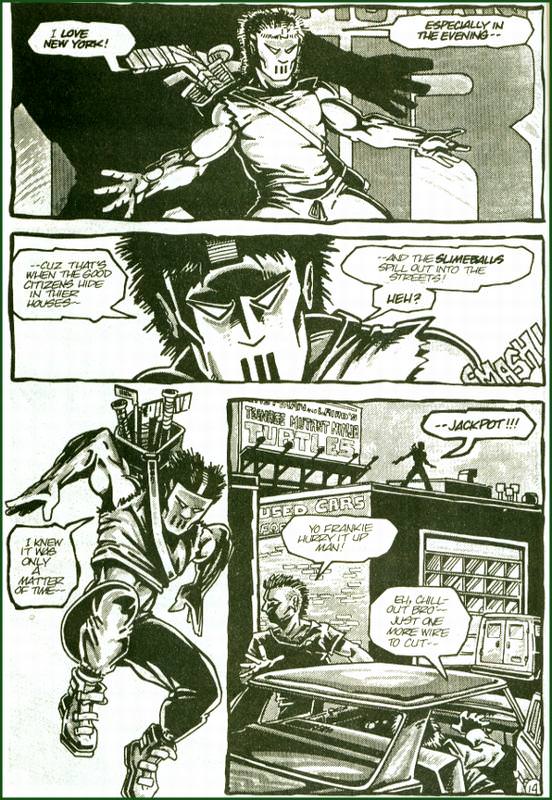
"He feels the organization is run by Ninjitsu fools who do not understand that true power does not come from weapons or money."
Original SA post
Teenage Mutant Ninja Turtles & Other Strangeness Revised Edition, Part Ten: "He feels the organization is run by Ninjitsu fools who do not understand that true power does not come from weapons or money."
The Leg of the Ninja
I can't... I can't make this up. See, you have the Foot Clan from Teenage Mutant Ninja Turtles, a parody of the Hand Ninja from Daredevil. And now you have "The Leg".

For one, why wouldn't you just use the Foot instead? I mean, they have the license, and fans want to fight the Foot, why would you have such an obvious knockoff? If it's intended as a parody, it's not apparent - there's no obvious joke other than the name. There's no apparent connection to the Foot Clan, either. And why wouldn't you go with the arm rather than the leg?
In any case, these are ninja smugglers. No art for any of the characters in this section, for the record.
Teenage Mutant Ninja Turtles and Other Strangeness posted:
Since the Leg is constantly loading or unloading shipments secretly, in strange neighborhoods, in the middle of the night, it's only a matter of time before the players' group discover them.
Yes, it's taken as an assumption that the PCs go around like Batman rooftop-watching alleyways and the like. Sure. It presumes they go in to disrupt the shipments, even though... it may not be obvious that they're illegal? Well, that's what they have to do for the adventure to work. It says when the players jump in, ninja will leap to its defense! More of a faction description than an adventure, it describes how encounters should escalate between the PCs and The Leg, with the ninja finally calling upon the "Tiger of the East" to eliminate them, and then when the Tiger presumably fails, they'll call out their biggest gun, "The Black One". We're told that their leadership in the US is "corrupt and stupid" - still dangerous, but apparently a far cry from their forebears.
We get rules for ninja thugs and their lieutenants, which are modest, though the lieutenants are surprisingly damaging. Then, we go into Kenu Kametsu's statblock, aka Long Strike. Long Strike is clearly supposed to be the first big boss PCs run into, and though he's one of the leaders, the pressure is too much for him and he's an opium addict, bullying those around him and wheedling when he's overcome. Despite that, he is a pretty tough customer and isn't afraid to use a sub-machinegun, which we're told is part of his "cowardice and lack of respect for tradition", but... guy's a ninja. Shouldn't a lack of respect for tradition be part of their point? The kind of folks who are willing to do anything to get stuff done? Well, no, here they're about honor, which apparently means not using any weapon invented after 1600.
Then we get Iya Ieyama, who is the head of the American branch of The Leg, who is a tougher customer and known as the Tiger of the West. He's actually a less competent combatant than Long Strike, but has a massive bonus to damage that makes any hit from him ridiculously damaging (he has a total of +17 to damage in a system where a +6 is pretty impressive). However, he's cautious and cowardly to a fault and won't enter any fight he doesn't think he can win. He also has a kusari-gama (that's a one-handed sickle with a chain attached) that is apparently of such fine craftsmanship that it gives a bonus to hit and damage. No other such weapon gets a bonus like that in the book, making it odd and its noteworthy in its mechanical ham-handedness. Now, if the plot ended there, other than the really dumb name of "The Leg", this'd be an alright hook, albeit a fairly generic one. But we've got one more shit up our sleeve.
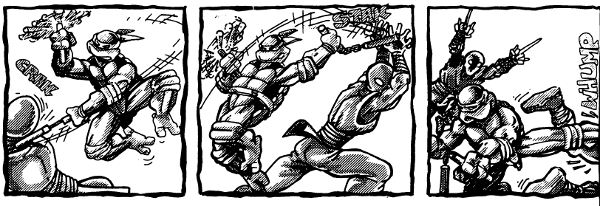
Once the PCs get past the bush league bosses, they have to face The Black One (not actually black). The retired head of The Leg (sigh), he lives under a fake name of... can I really type it? Can I? I guess I have to, now. He lives under the fake name of "Sushi Vojimbo". Sushi Vojimbo. It's not like, a joke or a pun. It's just a random collection of Japanese words, and an offensive one at that. But, well, 1985. In any case, he's a stereotype of the catankerous old asian man, who considers Kenu and Iya to be a bunch of fools who lack discipline. He regrets killing a rival when he was young, and so he never kills those he feels have potential for greatness. He works completely unarmed and alone, and that makes some sense you realize he's less of a character and more of a walking cutscene.
He's a "19th level ninja" (any other characters top out at 15th, for the record), but in addition, he has learned the "Lee Kwan Choo" martial art to 8th level, which we're told is a "mystic Chinese form of Kung Fu". This completely fictional fu lets him hit people for stunning blows that render foes helpless for 1d6 rounds, which means each hit can essentially kayo a target for a full minute with no saving throw. This alone would be enough to let him win fights, with his massive bonuses in combat. What's more, he has a Mental Affinity of 28, which is impossible for an ordinary human, which we're told he can use to stun foes outside of combat unless they roll above a 94 on d%. This isn't something you can actually do with Mental Affinity in the rules, but he can. What's more, he has a "+16 to leap away from combat", which has an implied meaning but doesn't have any clear rules application. Presumably that means he can get away really well. In addition, he has a Prowl of 98%, which we're told allows him to vanish at will, which isn't how the rules work, but okay.
Essentially, he's supposed to show up, and decide whether or not the PCs have potential. If he decides they don't, he'll likely trounce and kill them. If he decides they do have potential, he'll likely trounce them and nod sagely and vanish. Granted, he's not unstoppable, because he does have game numbers. But unless the PCs start just like pitching handfuls of grenades of him or set up crossfiring machineguns, they probably don't stand much of a chance. Oh, but if you have psionics, Wujcik didn't think to give him any defense against those, so a little Bio-Manipulation before he can slapstun you and he'll be twitching on the floor.
Whee.

We're told he could be the PC's mentor if you want to set them up in advance, then have a tweest where he turns out to be the retired head of the folks they were fighting all along, which is probably the best use for him if you can scrub out most of the blatant stereotyping and make him into a more interesting character. It notes that he also might show up later to save the PCs from something or other because he sees potential in them, or maybe not! He's asian and mysterious, two terms that may as well be synonomous in this description.
And that's the last of the "adventures", so we can move on the final parts of the book.
Sushi fuckin' Vojimbo, seriously?
Next: T.U.R.T.L.E. Power.
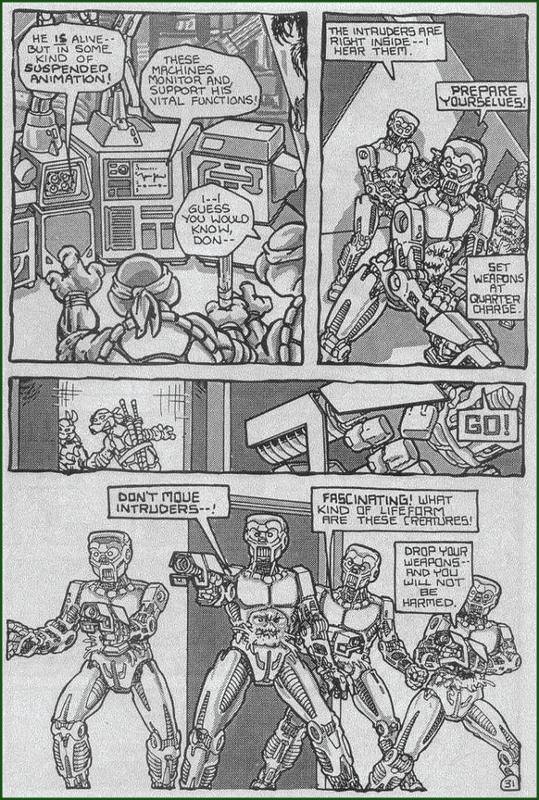
"In any event, as a young rat he was very intelligent, smart enough to be able to mimic and memorize the ninja techniques of his owner, Hamato Yoshi."
Original SA post
Teenage Mutant Ninja Turtles & Other Strangeness Revised Edition, Part Eleven: "In any event, as a young rat he was very intelligent, smart enough to be able to mimic and memorize the ninja techniques of his owner, Hamato Yoshi."
And finally, I get to nerdsplain about the Teenage Mutant Ninja Turtles.
For those less familiar, the Teenage Mutant Ninja Turtles were conceived by Kevin Eastman and Peter Laird in 1984 as a parody of a number of comic trends at the time - ninjas like in Daredevil, teenagers like in New Mutants, quirky anthropomorphics like in Cerebus, and a number of other books as well. Heavily influenced by Frank Miller and Jack Kirby, the whole thing played off the absurdity of turtle ninjas. The Daredevil parodies are fairly overt - a canister of ooze falls off a truck just like Daredevil (and even bounces off of not-Matt Murdock's head before hitting the turtles). Splinter is a direct parody of Daredevil's mentor, Stick, and The Foot is a direct parody of The Hand. The turtles got named off of painters mainly because the two concluded they couldn't come up with proper Japanese names. (Advice a certain writer probably could have used before coming up with names like "Sushi Vojimbo" or "Lee Kwan Choo".)
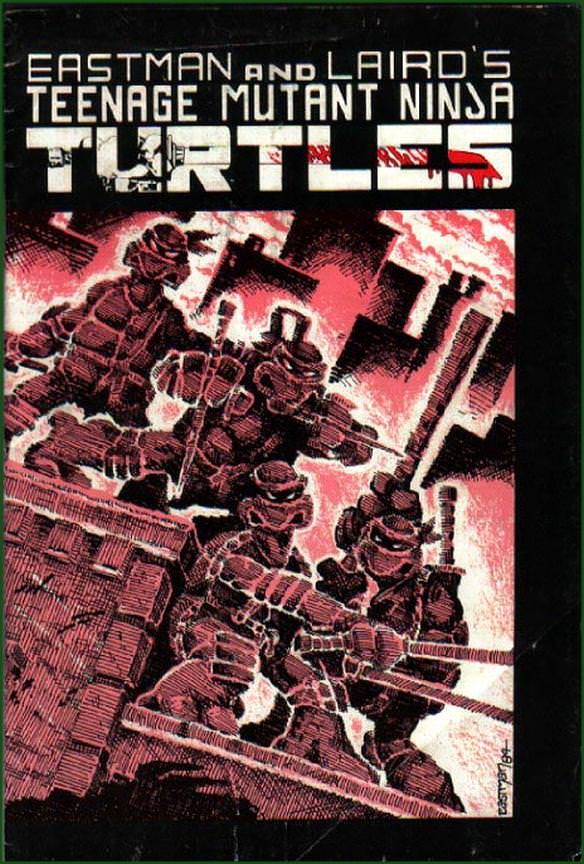
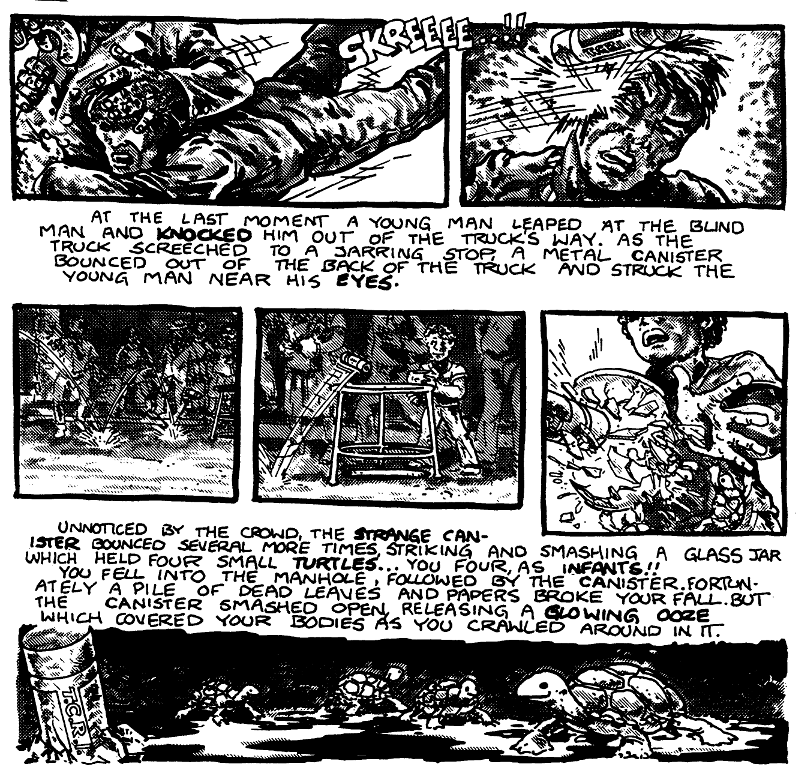
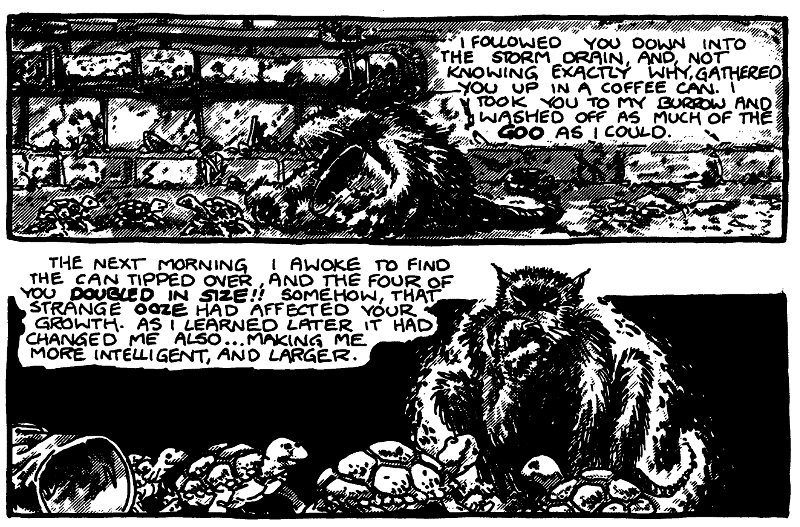
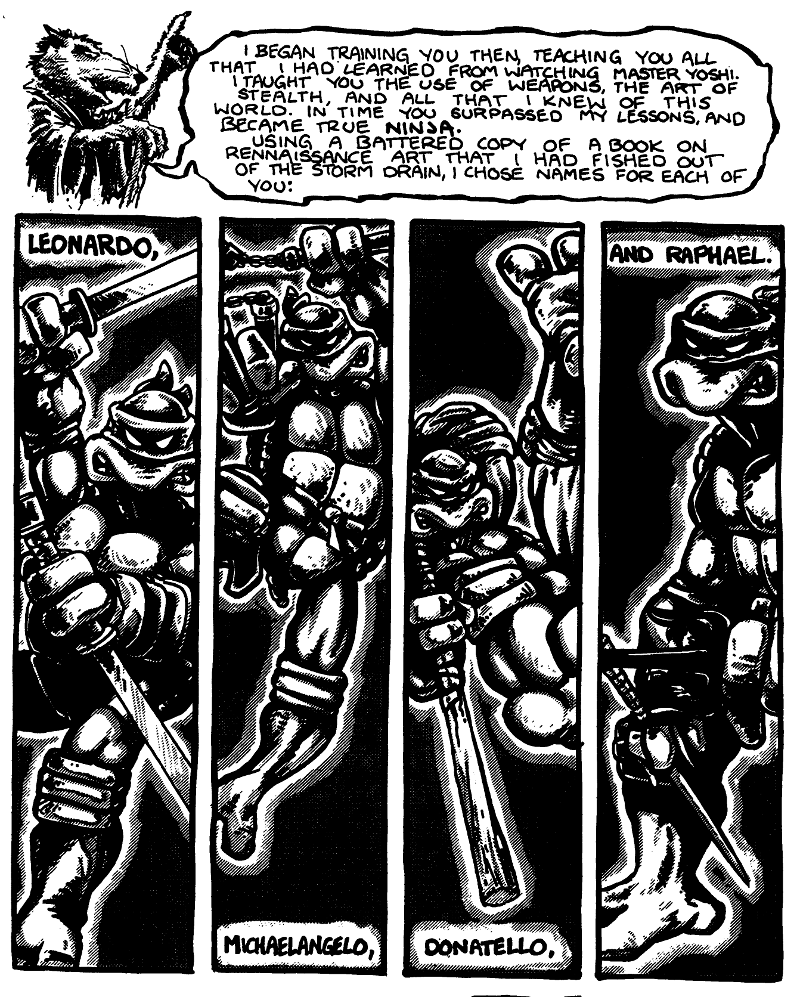
The origin in the original comics is slightly different than many of the later versions, and is reprinted in this book, but would be largely reused intact for the 1990 movie. In this one, two ninja named Hamato Yoshi and Oroku Nagi were members of the secretive Foot Clan. However, both were in love with a woman named Tang Shen, and were romantic and professional rivals. When Shen rejected Yoshi, he beat her to death, but Yoshi would discover this and kill Nagi in retribution. Fleeing the Foot, Yoshi and Shen fell in love, and lived in hiding in New York. Splinter was originally the pet rat of his owner, Hamato Yoshi. He learned ninjutsu by mimicking the motions of his master (yes, before becoming a mutant). However, Nagi's brother, Oroku Saki (aka the Shredder), would track Yoshi and Shen down and kill them for revenge. Splinter's cage was broken in the conflict, and he would flee into the sewers.
In the meantime, a young boy was carrying four turtles home from the pet shop, when a toxic canister bounced off a passing truck, shattering the bowl the turtles were in. Both the canister and turtles fell into an open manhole, where the canister shattered. Happening on the turtles, Splinter and the turtles were exposed to the toxic ooze. The ooze would eventually make them humanoid and sentient, and Splinter, retaining the ninja knowledge he had learned from his former owner.
It's pretty hackneyed, but you have to remember the original issue was intended in least in part as a parody, and was purposefully rather ridiculous. But it was successful, and more issues were to follow. Teenage Mutant Ninja Turtles and Other Strangeness is odd in that it predates the turtle toy craze by a fair bit, and only has material from the first four issues, plus a Raphael one-shot.
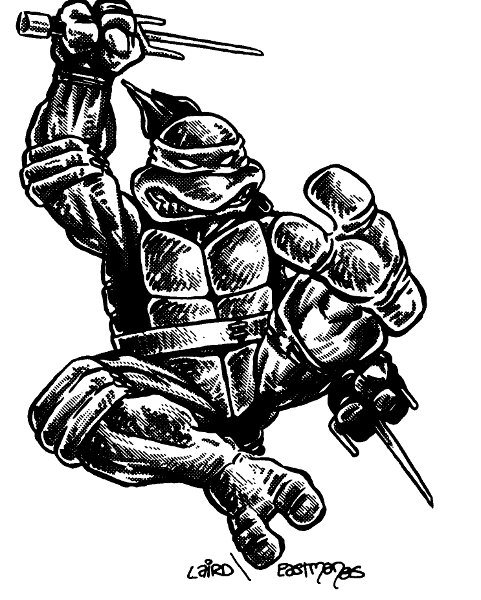
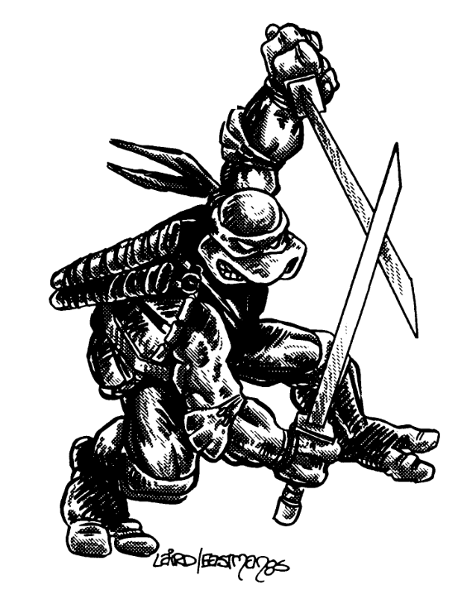
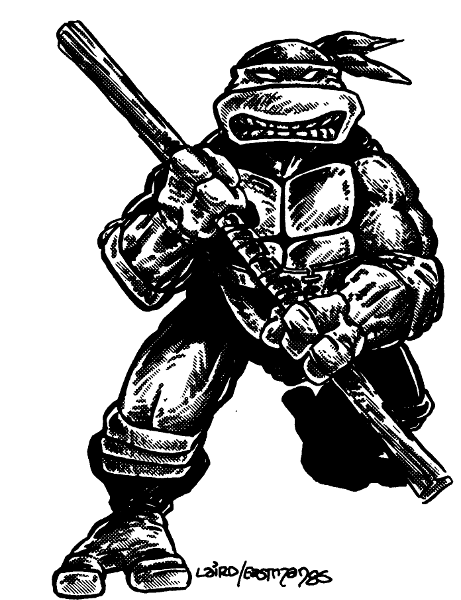
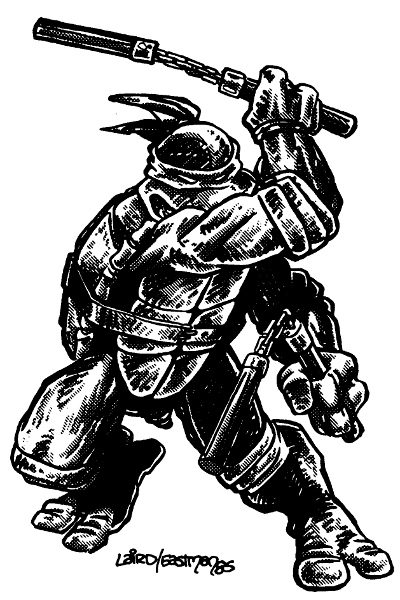
As far as write-ups go, most of them are actually very accurate to the black and white interpretations of the characters, which would be later exaggerated for cartoons. Raphael is represented as the strongest and toughest, though given to bouts of extreme anger. Leonardo is the perfectionist leader and is supposed to be all-around stat-wise. Donatello is the mechanically-inclined nerd who's the least martially inclined. And lastly, Michaelangelo is artisically inclined and more flighty, but has the greatest natural agility. Strangely, not all of them have the same level - Leo and Raph are 6th level while Don and Mike are 5th level. While this would presumably be there to represent their relative levels of enthusiasm for ninjutsu, it's still a bit odd. Additionally, the fact that they're of mid-range levels like that is particularly odd given they'd only had - at best - two or so story arcs in the comics. One would have to presume they've been having some prior unwritten adventures to earn the XP to get to that point. Another odd side effect of the Palladium system itself is that despite that, Michaelangelo is perhaps the most effective combatant, because he's got the top Physical Prowess, and Prowess is perhaps the primary determining factor for competency in melee combat. Only Raphael comes anywhere close, just on account of having the highest damage.
The other oddity that comes up is that the turtles cheat at the character creation system. Why this is so isn't clear, but they break the BIO-E point system.
pre:
Turtles start with 95 BIO-E at size level 1. The ninja turtles have: Size level 8 (35 BIO-E), full hands (10 BIO-E), full biped (10 BIO-E), full speech (10 BIO-E), hold breath (5 BIO-E), and heavy natural body armor (45 BIO-E). That's 115 BIO-E spent, folks. Whups.
Splinter gets perhaps the most tinkering; for a 12th level ninja, he gets surprisingly low stats and arbitrarily low combat bonuses because he's old, though he usually seems competent enough in the comics. It also implies he was probably a mutant before being exposed to the ooze, which is a way of trying to explain his relatively silly origin story. He also has a wide variety of skills that don't exist in the game, like "Study Japanese Literature" or "Study Oriental Philosophy". Mind, so do some of the turtles - Michaelangelo has "Study, Science Fiction" and "Study, Comic Books", other nonexistent skills.
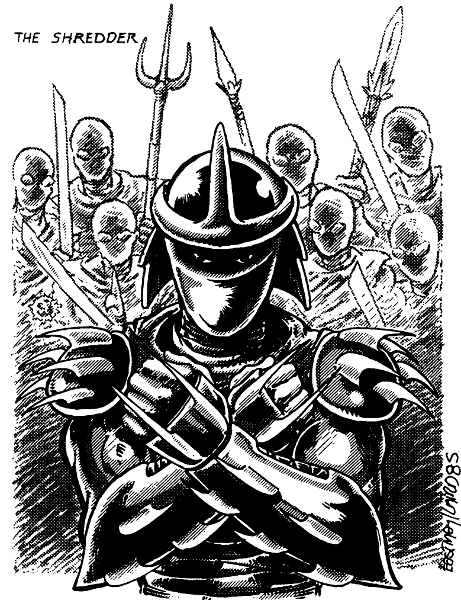
Though Oroku Saki dies in the first issue, the Shredder still gets a writeup. Granted, he would eventually make a comeback in the comics - only to die again, but both facts are well beyond being known at the game's publication. Instead, it just points out the turtles never looked too hard for a body. He's described as ruthless crime lord and "almost unstoppable" as the Shredder, even though his combat bonuses really just put him only modestly above the turtles themselves. (Considering how they well murder him in the comics, this probably fits, but he's not to be used as a singular antagonist.) The writeup of the Foot itself is partly accurate and partly whole cloth. It points out they're modern ninja who are willing to use weapons and surveillance devices (true), but also says they're ruled by a Council of Eight headed by "The Faceless One" (false). Curiously, it associates them as the secret bosses of the Purple Dragon gang - which wouldn't be true in the comic itself, but would be true in later cartoons that would develop the Purple Dragons into actual characters. Strangely, the Foot ninja themselves get no writeup - though you could probably use The Leg ninja statblocks for them just fine.
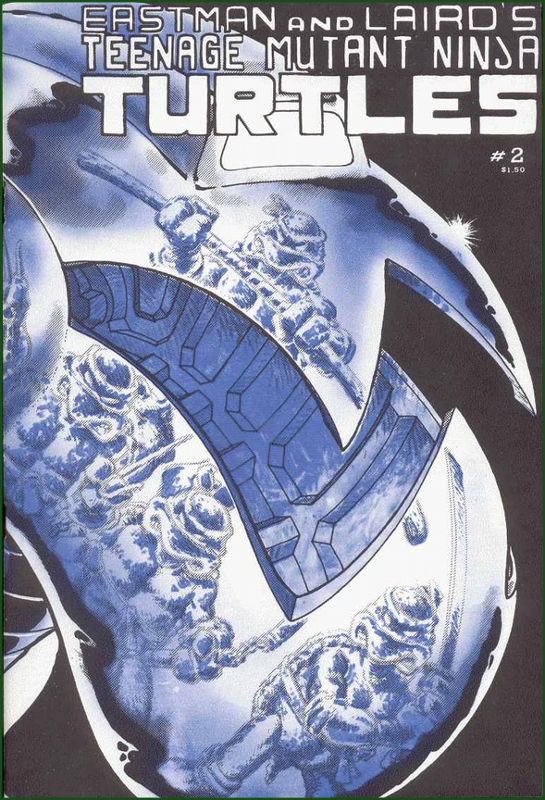
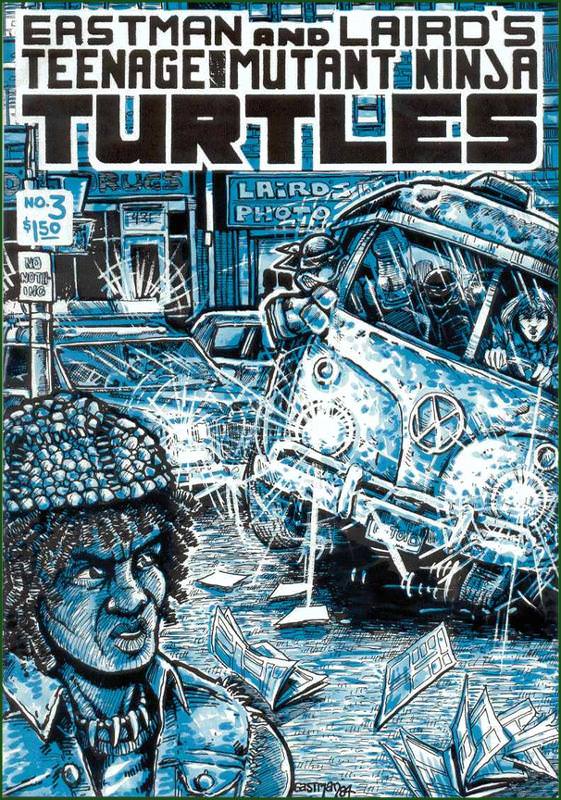
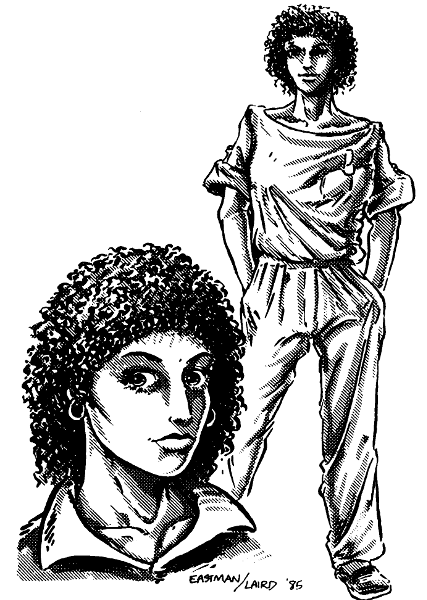
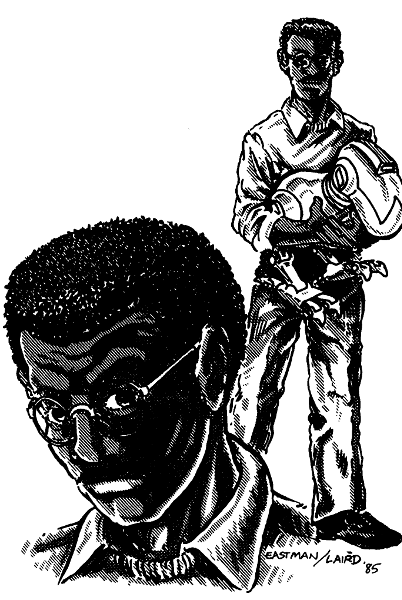
In the second issue, we have two mainstays of the franchise that are introduced: April O'Neil and Baxter Stockman. April is a computer programmer who inherited a "junk store" from her father that she runs. (She's not a reporter in the original comics.) She works as an assistant for Stockman, who is an inventor funded by New York City to come up with robots to be used for pest control called "mousers". And though the mousers could certainly catch rats, their primary purpose was to dig and collapse buildings, which Stockman used to try and hold New York sites for ransom - largely out of psychopathic amusement more than greed. April, upon finding out his scheme, fled into the underground sewers where she met the turtles, who helped her stop Stockman's scheme and turned him over to the authorities. However, the mousers would find and attack Splinter due to their programming, and the turtles would only find his bloody, shredded clothes.
April is a "1st level computer programmer" with a ridiculously high skill totals for her level, but is essentially helpless in terms of her combat stats. Baxter Stockman is 3rd level with numerous top-end technical skills, but bizarrely has only 1 attack a round and 0 S.D.C. - he may as well be an invalid, with combat skills that are more what one might expect from literal baby for some reason. In the comics, he actually fights one of the turtles off for a moment, which seems to counter that notion. (For those that remember him as a mutant fly from the cartoons, that never happens in the original comics. He does become a robot later on, however.) The mousers themselves are surprisingly tough combatants - though they don't defend themselves, it'll take about 6-7 swings for a character like Leonardo to take one down, and they do more damage than most armed melee combatants in the game. It's a problematic statblock, given that they can probably overwhelm PCs with numbers thanks to their durability.
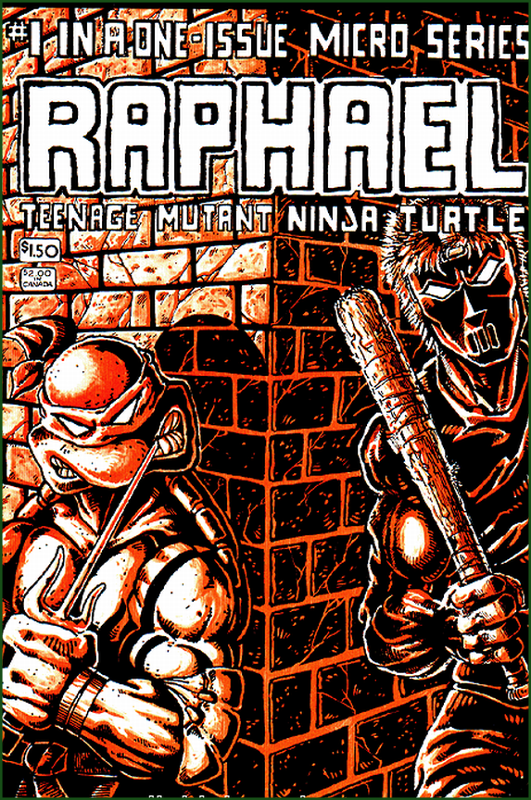
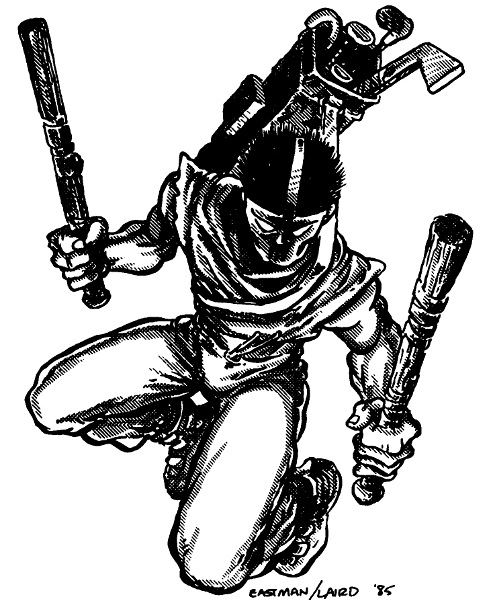
Casey Jones is a handyman who moonlights as a everyman vigilante, inspired and informed by cop shows and news shows. With a hockey mask and sports equipment, he goes out and beats criminals ruthlessly. It's this activity that brings him into conflict with Raphael, as the mutant turtles works to curb his more brutal tendencies, but the two quickly become best bros in the interest of beating up baddies. His actual statblock is strangely anemic, with no physical skills (!) despite his description and background of constant bodybuilding. His high physical stats make him a competent combatant, but not nearly near the turtles themselves - which is definitely lowballing him, but it's understandable given he had only one appearance at the time of this printing.
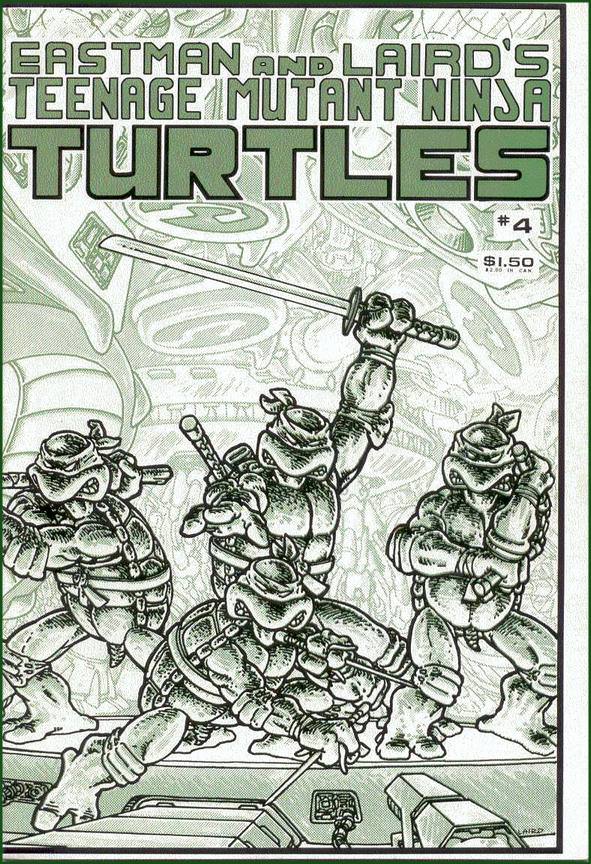
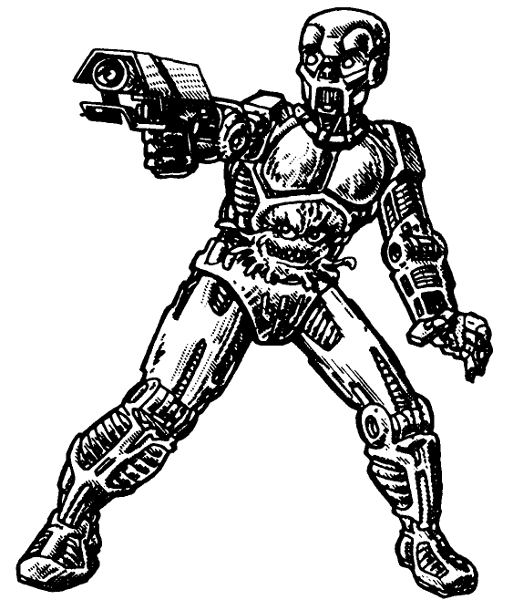
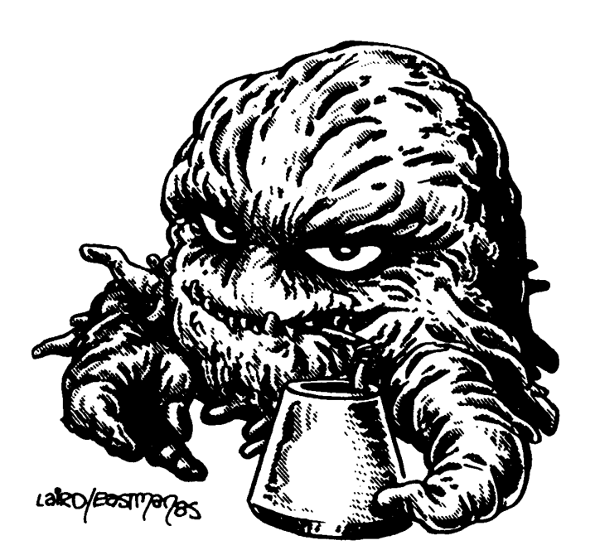
Lastly, from the comics, we get the T.C.R.I. Aliens. See, the canister of ooze that created the turtles had the acronym "T.C.R.I." printed on it. When exploring the city, the turtles would happen across a building with the same logo. Investigating it, they would find strange researchers and a stranger science facility, and then would come across Splinter's body in a tube. Freaking out, they would get into a fight with T.C.R.I. (the "Techno-Cosmic Research Institute") who turned out to be brain-like aliens who dress in robotic exoskeletons to disguise themselves as humans. We'll have more on them in a later supplement, but the interesting thing to note here is that they're not hostile - they're just trying to find a way off of Earth and back home. This stands in contrast to Krang, the villain they'd inspire in the cartoon, who's more of a cookie cutter baddie. We're told the that the ooze is a "microbial agent" created as a "by-product" from "producing organic circuitry". Not sure that has any basis, but it's a decent an explanation as any.
And that's that - essentially all the characters from the five issues of the comic that spawned this game. We'll really only get two more supplements inspired by the comic - Teenage Mutant Ninja Turtles Guide to the Universe and Transdimensional Teenage Mutant Ninja Turtles - and the rest will come from Palladium spinning whole cloth.
Next: Original TMNT OCs, do not steal.
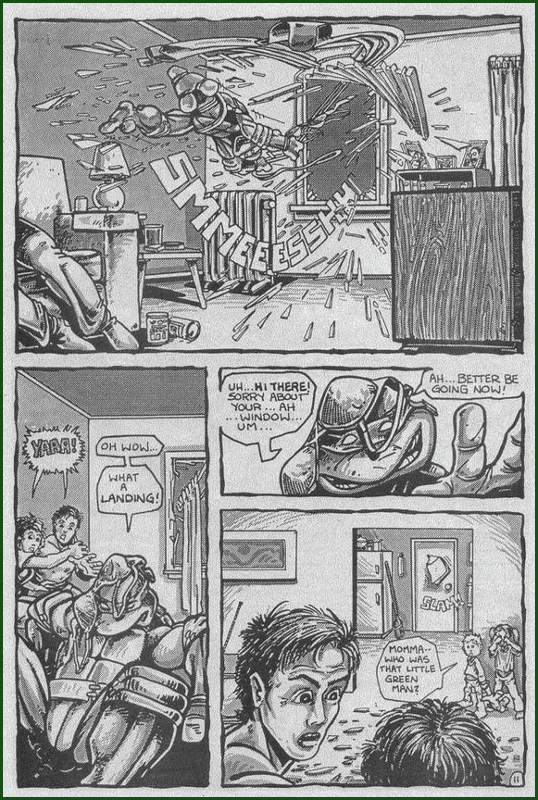
Well, it was the eighties.
"Their intention was to genetically alter a creature that could explore and actually dig for oil."
Original SA post
Teenage Mutant Ninja Turtles & Other Strangeness Revised Edition, Part Twelve: "Their intention was to genetically alter a creature that could explore and actually dig for oil."
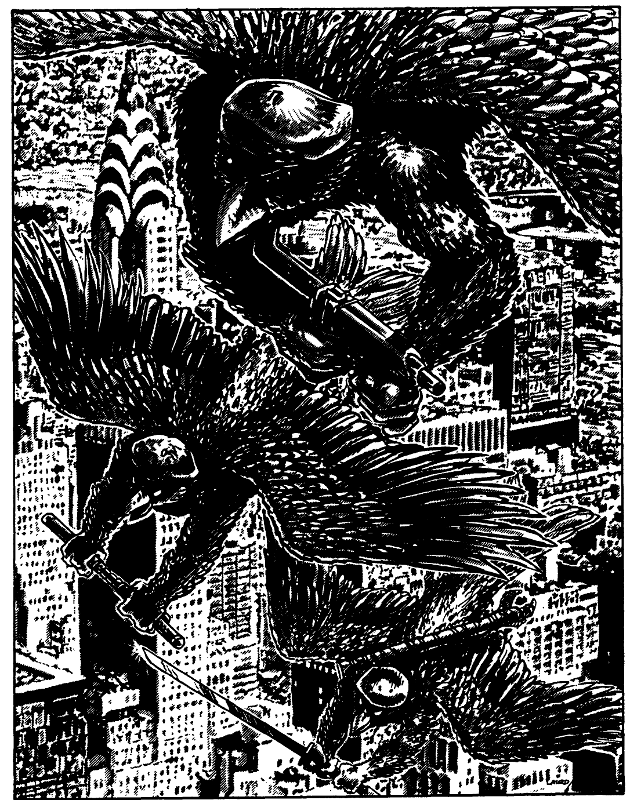
Lastly, we wrap up the book with what seem to be either sample or playtest characters; there's no introduction or explanation for these characters, but they're not from the comics. The first are a set of three teenage mutant ninja sparrows called the "Sparrow-Eagles" - Chirp Yenko (uses nunchaku), Brown Wing (uses swords or bow), and Gorba Chirp (uses sword or sub-machine gun). Get it? Because communists, ha ha?... well, there was a time anything vaguely Russian was a punchline, and that time was the '80s. Anyway, we don't get any background on these guys other than that they're 3rd level ninjas and some vague personality traits.
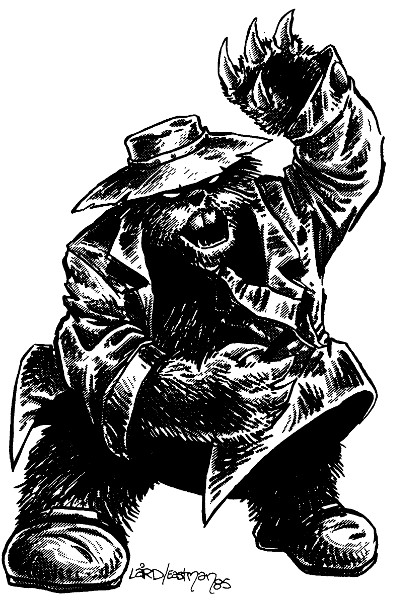
Fred Hamster is a mutant hamster created by an oil company to explore and dig for oil. However, when he discovered he might be replaced by a newer model of mutant, he escaped with a truckful of weapons, money, and mining equipment. He's no ninja, but he does have the ability to dig and lots of explosives. I kinda like Fred as a scrappy one-hamster blow against the oil industry. He gets a pass.
Wait, did my gas prices go up?
Fuck you, Fred.
Lately, we get an ad for various supplements for the game, as well as other Palladium RPGs of the time.
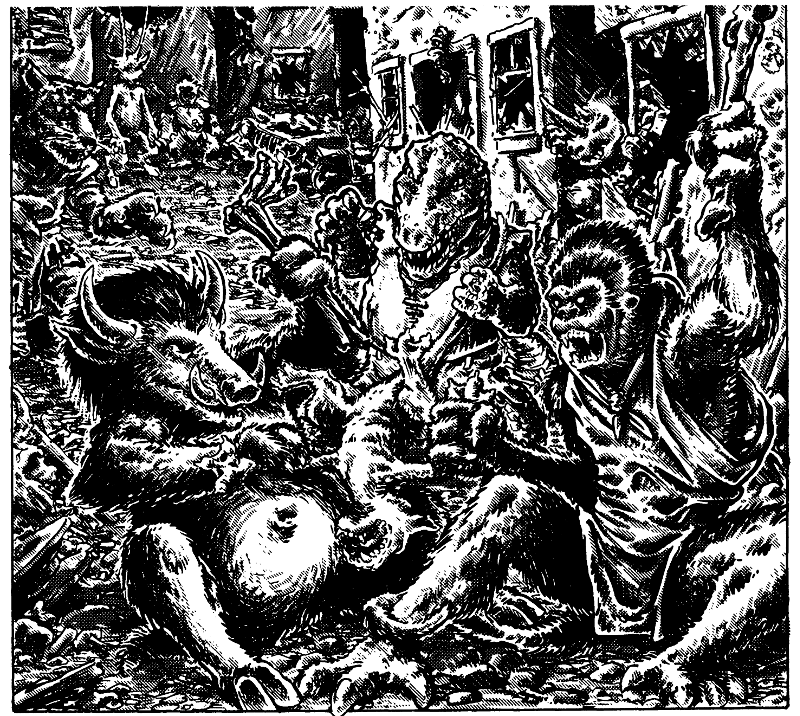
This was creepy as hell to end the book with, as a kid.
Teenage Mutant Ninja Turtles and Other Strangeness, at the very least, lives up to its name. A hit with no real imitators, the genre of "modern martial arts anthropomorphics" would hit like wildfire... and pass just as quickly. About the closest thing we'd see again in the genre would be Werewolf, but that would take a be a much more splatterpunk and exaggerated version of a similar notion. Though Palladium would go on to abandon the license, they still publish After the Bomb, an post-apocalyptic RPG centering around mutant animals. However, even After the Bomb essentially got no official support once the license closed, aside from on-and-off "unofficial" articles in The Rifter. Apparently, there was some discussion of a second edition shortly before its cancellation, and they looked into reviving it around the time of 2007's TMNT, but the Turtles never returned to RPGs - by Palladium or anybody else. Granted, the massively increased popularity of the turtles and their acquisition by Nickelodeon has no doubt fired their licensing costs into the stratosphere, making the prospect of a future turtles RPG seems intensely slim unless IDW turns their eye to RPGs.
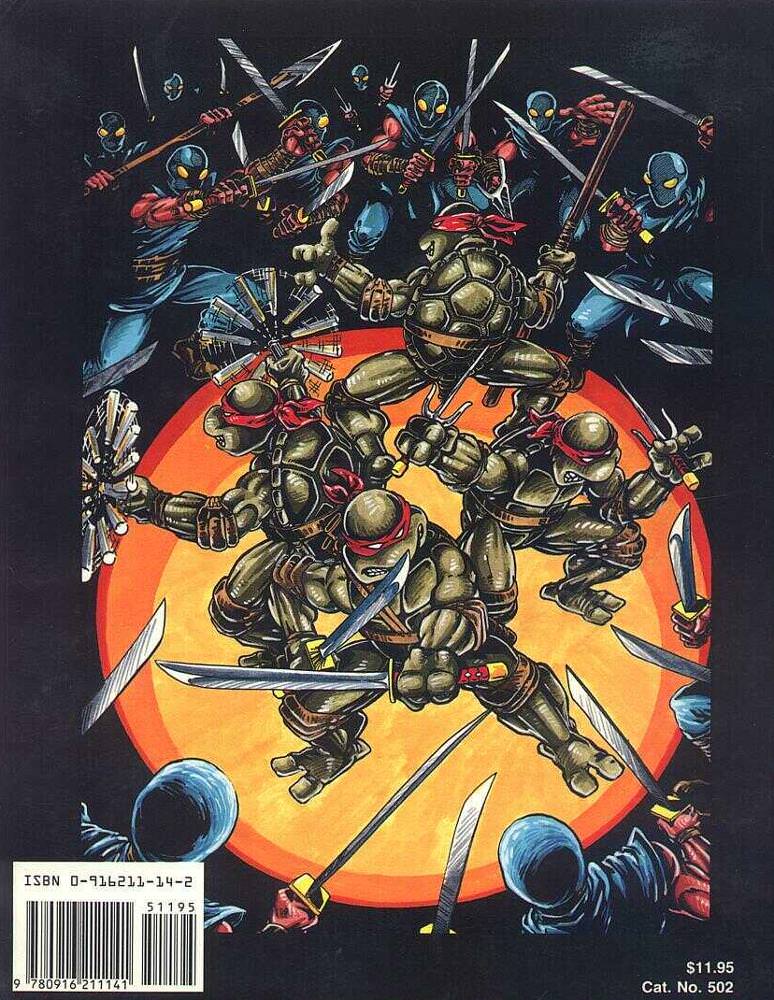
Palladium blames the "kiddifying" of the turtles, but it's interesting to note that they didn't chase the younger audience at all, either, instead and just trying to promote a potential second edition through giveaways of ten-year-old book and ads in Marvel comics, delaying it over and over in an attempt to build hype. As the turtles became more popular, ironically, the Palladium RPG sales went down, and they cancelled the license in 2000, eight years after the last book published for it in 1992 (the dual-setting Mutants in Orbit, which I've reviewed as Rifts Space). All in all, there were only six total books produced for the main line, with another eight After the Bomb books. It's a game very much of its time, abandoned if not forgotten.
And we're done here.
